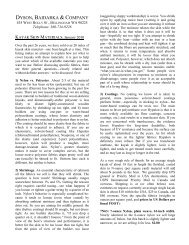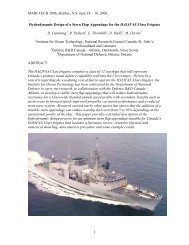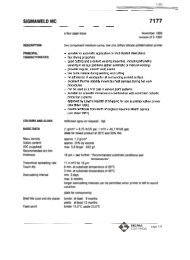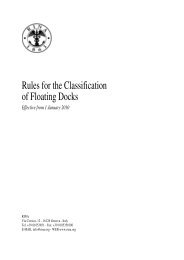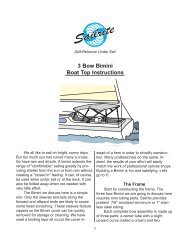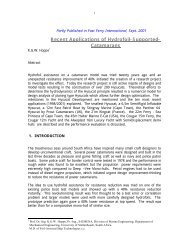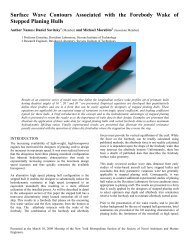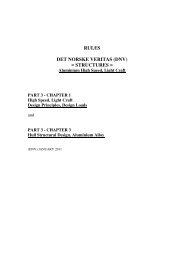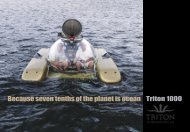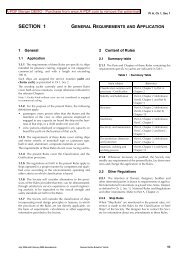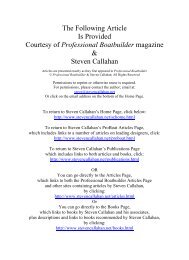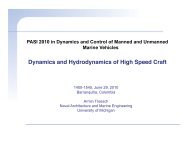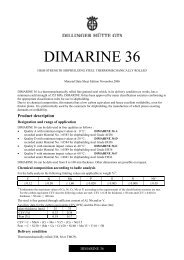Origin and Characteristics of the Spray Patterns TR-2882 3-10 ...
Origin and Characteristics of the Spray Patterns TR-2882 3-10 ...
Origin and Characteristics of the Spray Patterns TR-2882 3-10 ...
You also want an ePaper? Increase the reach of your titles
YUMPU automatically turns print PDFs into web optimized ePapers that Google loves.
<strong>TR</strong>-<strong>2882</strong><br />
Davidson Laboratory<br />
Marine Hydrodynamics,<br />
Coastal & Ocean Engineering<br />
TECHNICAL REPORT SIT-DL-<strong>10</strong>-1-<strong>2882</strong><br />
January, 20<strong>10</strong><br />
<strong>Origin</strong> <strong>and</strong> <strong>Characteristics</strong> <strong>of</strong> <strong>the</strong> <strong>Spray</strong> <strong>Patterns</strong><br />
Generated by Planing Hulls<br />
by<br />
Daniel Savitsky<br />
Michael Morabito<br />
.<br />
Castle Point on Hudson,<br />
Hoboken, NJ 07030<br />
<strong>TR</strong>-<strong>2882</strong>
<strong>TR</strong>-<strong>2882</strong><br />
Davidson Laboratory<br />
Stevens Institute <strong>of</strong> Technology<br />
Hoboken, New Jersey 07030<br />
ORIGIN AND CHARACTERISTICS OF THE SPRAY PATTERNS<br />
GENERATED BY PLANING HULLS<br />
Report No <strong>2882</strong><br />
By<br />
Daniel Savitsky*<br />
Michael Morabito**<br />
January, 20<strong>10</strong><br />
* Pr<strong>of</strong>essor Emeritus, Stevens Institute <strong>of</strong> Technology<br />
** Research Engineer, Davidson Laboratory, Stevens Institute <strong>of</strong> Technology<br />
Presented at <strong>the</strong> March 20<strong>10</strong> meeting <strong>of</strong> <strong>the</strong> New York Metropolitan Section<br />
<strong>of</strong> The Society <strong>of</strong> Naval Architects <strong>and</strong> Marine Engineers.
<strong>TR</strong>-<strong>2882</strong><br />
<strong>Origin</strong> <strong>and</strong> <strong>Characteristics</strong> <strong>of</strong> <strong>the</strong> <strong>Spray</strong> <strong>Patterns</strong><br />
Generated by Planing Hulls<br />
Author Names:<br />
Daniel Savitsky, Member<br />
Michael Morabito, Associate Member<br />
ABS<strong>TR</strong>ACT<br />
Analytical <strong>and</strong> experimental studies were made <strong>of</strong> <strong>the</strong> origin <strong>and</strong> characteristics <strong>of</strong> <strong>the</strong> two distinctly<br />
different appearing spray patterns associated with prismatic planing hulls. It was found that <strong>the</strong>se two<br />
spray patterns, identified as “whisker spray” <strong>and</strong> “main spray”, are a consequence <strong>of</strong> <strong>the</strong> same basic<br />
hydrodynamic flow phenomenon <strong>and</strong> transform seamlessly from one into <strong>the</strong> o<strong>the</strong>r.<br />
Similar to <strong>the</strong> analytical treatment developed for swept-wing aircraft, where <strong>the</strong> oncoming free stream<br />
velocity is divided into components normal to <strong>and</strong> along <strong>the</strong> leading edge <strong>of</strong> <strong>the</strong> swept wing, <strong>the</strong> free<br />
stream velocity for <strong>the</strong> planing surface is divided into components normal to <strong>and</strong> along <strong>the</strong> stagnation<br />
line. Combining this orientation <strong>of</strong> velocity components with <strong>the</strong> results <strong>of</strong> analytical studies <strong>of</strong> H.<br />
Wagner (1932) for two-dimensional planing <strong>of</strong> infinitely long flat planing surfaces with those <strong>of</strong> A. E.<br />
Green (1935) for planing <strong>of</strong> a two dimensional, finite length surface, explains <strong>the</strong> origin <strong>and</strong><br />
characteristics <strong>of</strong> both <strong>the</strong> whisker <strong>and</strong> main spray patterns. It is shown that <strong>the</strong> main spray originates<br />
in a small local area at <strong>the</strong> intersection <strong>of</strong> <strong>the</strong> stagnation line with <strong>the</strong> chine. Relatively simplistic<br />
equations, that define <strong>the</strong> three dimensional location <strong>of</strong> <strong>the</strong> spray apex, are developed <strong>and</strong> <strong>the</strong> results<br />
presented in three graphs. An illustrative example is presented that demonstrates <strong>the</strong> ease <strong>of</strong><br />
application <strong>of</strong> <strong>the</strong> method to define <strong>the</strong> main spray geometry <strong>of</strong> a typical planing craft.<br />
Model tests were conducted to define <strong>the</strong> maximum height <strong>of</strong> <strong>the</strong> main spray <strong>and</strong> its lateral <strong>and</strong><br />
longitudinal positions relative to <strong>the</strong> hull as a function <strong>of</strong> deadrise angle, trim angle <strong>and</strong> speed<br />
coefficient. These data substantiate <strong>the</strong> analytical results.<br />
KEY WORDS: planing hulls, main spray, whisker spray<br />
NOMENCLATURE<br />
b = chine beam (ft, m)<br />
Cv = speed coefficient = V gb<br />
l = length <strong>of</strong> flat plate (ft, m)<br />
l 1 = distance from trailing edge to stagnation point <strong>of</strong> flat plate (ft, m)<br />
l 2 = distance from stagnation point to leading edge <strong>of</strong> flat plate (ft, m)<br />
lm = distance from trailing edge to spray root <strong>of</strong> flat plate (ft, m)<br />
ls = length <strong>of</strong> stagnation line, between keel <strong>and</strong> chine (ft, m)<br />
l WL = static wetted length <strong>of</strong> flat plate (ft, m)<br />
Lc = wetted chine length (beams)<br />
Lk = wetted keel length (beams)<br />
Ltr = length <strong>of</strong> spray trajectory from <strong>the</strong> intersection <strong>of</strong> <strong>the</strong> chine <strong>and</strong> <strong>the</strong> stagnation line to <strong>the</strong> point <strong>of</strong> maximum<br />
height in <strong>the</strong> horizontal plane (ft, m)<br />
Lws = length <strong>of</strong> whisker spray along chine (ft, m)<br />
V = speed <strong>of</strong> planing hull (ft/sec, m/sec)<br />
Vn = velocity component normal to stagnation line (ft/sec, m/sec)<br />
Vk = speed <strong>of</strong> planing hull (knots)<br />
Vs = velocity component along stagnation line (ft/sec, m/sec)<br />
Vv = vertical velocity <strong>of</strong> spray (ft/sec, m/sec)<br />
tm = time to reach maximum height <strong>of</strong> trajectory (seconds)<br />
X = horizontal distance between main spray origin <strong>and</strong> maximum height <strong>of</strong> main spray (ft, m)<br />
Y = lateral distance between side <strong>of</strong> hull <strong>and</strong> maximum height <strong>of</strong> main spray (ft, m)<br />
1
<strong>TR</strong>-<strong>2882</strong><br />
Z = maximum height <strong>of</strong> main spray relative to level water surface (ft, m)<br />
X’ = horizontal distance between main spray origin <strong>and</strong> maximum height <strong>of</strong> main spray (beams)<br />
Y’ = lateral distance between side <strong>of</strong> hull <strong>and</strong> maximum height <strong>of</strong> main spray (beams)<br />
Z’ = maximum height <strong>of</strong> main spray relative to level water surface (beams)<br />
α = angle between stagnation line <strong>and</strong> keel, deg<br />
β = deadrise angle, deg.<br />
βe = effective angle <strong>of</strong> deadrise measured in a plane normal to <strong>the</strong> bottom <strong>and</strong> along <strong>the</strong> stagnation line, deg<br />
βt = reduction <strong>of</strong> trajectory angle due to <strong>the</strong> geometric effect <strong>of</strong> trim angle, deg<br />
γ = trajectory angle <strong>of</strong> main spray with respect to level water at chine, deg<br />
Δ = displacement<br />
θ = swept angle <strong>of</strong> wing, deg.<br />
σ = spray thickness, in fractions <strong>of</strong> wetted length<br />
τ = trim angle, deg<br />
τ RAD = trim angle, radians<br />
IN<strong>TR</strong>ODUCTION<br />
A typical spray formation associated with planing hulls is shown on Fig.1. Two distinct spray patterns are evident in<br />
this photograph. One is <strong>the</strong> so-called ‘whisker” spray <strong>and</strong> <strong>the</strong> o<strong>the</strong>r is called <strong>the</strong> main spray. Characteristically, <strong>the</strong><br />
whisker spray is a thin, light, spray consisting <strong>of</strong> droplets <strong>of</strong> water that are projected outboard <strong>of</strong> <strong>the</strong> chine at a<br />
trajectory angle essentially equal to <strong>the</strong> local hull deadrise angle. The main spray is a discharge <strong>of</strong> water in <strong>the</strong> form <strong>of</strong><br />
a cone whose apex is in <strong>the</strong> vicinity <strong>of</strong> <strong>the</strong> stagnation line intersection with <strong>the</strong> chine <strong>and</strong> whose outboard trajectory is<br />
elevated significantly relative to that <strong>of</strong> <strong>the</strong> whisker spray. While distinctly different in appearance, this report<br />
demonstrates that both spray patterns are a consequence <strong>of</strong> <strong>the</strong> same hydrodynamic phenomenon.<br />
Because <strong>of</strong> <strong>the</strong> large volume <strong>of</strong> water <strong>and</strong> <strong>the</strong> high trajectory angle <strong>of</strong> <strong>the</strong> main spray, it can impinge upon <strong>the</strong> wings<br />
<strong>and</strong> propellers <strong>of</strong> seaplanes to produce structural damage; it can also impact <strong>the</strong> tunnel between <strong>the</strong> hulls <strong>of</strong> a planing<br />
catamaran (with symmetric hulls) to significantly increase <strong>the</strong> hull resistance; <strong>and</strong> in a head wind it can be blown into<br />
<strong>the</strong> craft making for an uncomfortably wet environment. In addition, it may impact <strong>the</strong> wings <strong>of</strong> a “wing in ground<br />
effect” (WIG) craft since <strong>the</strong>se marine vehicles require <strong>the</strong> wings to be located at relatively small distances above <strong>the</strong><br />
water. A designer would be well served if <strong>the</strong> trajectory <strong>of</strong> <strong>the</strong> main spray was defined in terms <strong>of</strong> hull geometry <strong>and</strong><br />
operating conditions.<br />
Savitsky <strong>and</strong> Breslin (1958) conducted a series <strong>of</strong> tests <strong>of</strong> four constant deadrise hulls towed behind a wind screen to<br />
define <strong>the</strong> geometry <strong>of</strong> <strong>the</strong> main spray (prior to its breakup into intense droplets) as a function <strong>of</strong> hull deadrise angle,<br />
trim angle, <strong>and</strong> speed coefficient. The focus <strong>of</strong> that study was on <strong>the</strong> operating conditions <strong>of</strong> seaplanes <strong>and</strong> <strong>the</strong><br />
distribution <strong>of</strong> <strong>the</strong> test results was limited to designers <strong>of</strong> seaplanes <strong>and</strong> to agencies <strong>of</strong> <strong>the</strong> United States government.<br />
Unfortunately, <strong>the</strong> small craft design community is generally unaware <strong>of</strong> <strong>the</strong> existence <strong>of</strong> this effort.<br />
The present study develops an analytical method for defining <strong>the</strong> origin <strong>and</strong> geometry <strong>of</strong> <strong>the</strong> spray components <strong>and</strong><br />
<strong>the</strong>ir locations relative to <strong>the</strong> planing hull. Also, a model test program was carried out to measure <strong>the</strong> spray geometry as<br />
a function <strong>of</strong> hull deadrise, trim angle <strong>and</strong> speed <strong>and</strong> to compare <strong>the</strong> results with <strong>the</strong> analytical predictions. In contrast<br />
to <strong>the</strong> test conditions <strong>of</strong> Savitsky <strong>and</strong> Breslin, (1958), where a wind screen was towed ahead <strong>of</strong> <strong>the</strong> model <strong>and</strong><br />
measurements <strong>of</strong> <strong>the</strong> spray heights were made prior to <strong>the</strong> break-up <strong>of</strong> <strong>the</strong> spray into droplets, <strong>the</strong> present test program<br />
did not include a wind-screen <strong>and</strong> spray heights were measured from <strong>the</strong> level water surface to <strong>the</strong> top <strong>of</strong> <strong>the</strong> brokenspray<br />
ORIGIN OF SPRAY PATTERNS DEVELOPED BY A PLANING HULL<br />
Geometric Appearance <strong>of</strong> Hull Intersection with Free Water Surface<br />
In order to describe <strong>the</strong> origin <strong>of</strong> <strong>the</strong> two basic spray forms associated with high speed planing hulls it is first necessary<br />
to describe <strong>the</strong> free water surface intersections with <strong>the</strong> hull as shown on <strong>the</strong> sketches in Fig. 2.<br />
At pre-planing speeds <strong>the</strong> spray patterns do not develop but ra<strong>the</strong>r a small bow wave originates at <strong>the</strong> chine intersection<br />
with <strong>the</strong> water surface. This bow wave is a divergent wave formation <strong>and</strong> is akin to <strong>the</strong> gravity waves that exist for<br />
displacement vessels. At low speeds, <strong>the</strong> bow wave is <strong>the</strong> only visible water surface disturbance. As <strong>the</strong> speed<br />
increases, droplets <strong>of</strong> whisker spray <strong>and</strong> a small main spray blister appear slightly outboard <strong>of</strong> <strong>the</strong> crest <strong>of</strong> <strong>the</strong> bow<br />
wave. At high planing speeds <strong>the</strong> whisker <strong>and</strong> main spray formations become higher <strong>and</strong> larger so that <strong>the</strong>y dominate<br />
2
<strong>TR</strong>-<strong>2882</strong><br />
<strong>and</strong> completely obscure <strong>the</strong> bow wave. For all speeds, <strong>the</strong> height <strong>of</strong> bow wave crest is relatively small. These<br />
characteristics are demonstrated by a series <strong>of</strong> photographs taken by Savitsky <strong>and</strong> Breslin (1958). These are reproduced<br />
<strong>and</strong> discussed in <strong>the</strong> test section <strong>of</strong> this report.<br />
While many <strong>of</strong> <strong>the</strong> notations in Fig. 2 are self explanatory, it is important to define <strong>the</strong> stagnation line <strong>and</strong> <strong>the</strong> spray<br />
root line. Specifically, <strong>the</strong> stagnation line is a locus <strong>of</strong> points on <strong>the</strong> bottom along which <strong>the</strong> flow is divided into<br />
forward <strong>and</strong> aft components <strong>and</strong> on which <strong>the</strong> pressure is a maximum <strong>and</strong> is developed from bringing to rest <strong>the</strong><br />
component <strong>of</strong> free stream velocity normal to this line. ( fur<strong>the</strong>r discussion is given in a subsequent section <strong>of</strong> this<br />
report). Just forward <strong>of</strong> <strong>the</strong> stagnation line is <strong>the</strong> so-called spray root line. This defines <strong>the</strong> forward extent <strong>of</strong> <strong>the</strong> wetted<br />
bottom area when planing. According to <strong>the</strong>oretical (Wagner, 1932) <strong>and</strong> experimental (typically Savitsky <strong>and</strong><br />
Neidinger, 1954) results, <strong>the</strong> actual wetted width at any cross section through <strong>the</strong> bottom is essentially π/2 times <strong>the</strong><br />
wetted width defined by <strong>the</strong> level water line intersection with <strong>the</strong> bottom. This is referred to as <strong>the</strong> “wave-rise’ factor.<br />
The angle <strong>of</strong> <strong>the</strong> spray root line, α, relative to <strong>the</strong> keel measured in a plane normal to <strong>the</strong> hull centerline <strong>and</strong> along <strong>the</strong><br />
keel can be established from a knowledge <strong>of</strong> <strong>the</strong> deadrise, trim <strong>and</strong> π/2 wave rise factor. Thus, it can be shown that:<br />
α =<br />
⎛ π tanτ<br />
⎞<br />
⎜ ⎟<br />
⎝ 2 tan β ⎠<br />
−1<br />
Tan Eq. 1<br />
Because <strong>the</strong> stagnation line <strong>and</strong> <strong>the</strong> spray root line are very close to each o<strong>the</strong>r, <strong>the</strong> π/2 wave rise factor is <strong>of</strong>ten applied<br />
to both lines.<br />
Also shown on Fig.2 is <strong>the</strong> forward extent <strong>of</strong> <strong>the</strong> whisker spray area. Subsequent sections <strong>of</strong> this paper compute <strong>the</strong><br />
angle between <strong>the</strong> keel <strong>and</strong> <strong>the</strong> forward boundary <strong>of</strong> this spray component. Savitsky, Delorme, <strong>and</strong> Datla, (2007)<br />
presented a method for estimating <strong>the</strong> viscous resistance <strong>of</strong> <strong>the</strong> fluid that traverses this hull bottom area before being<br />
projected from <strong>the</strong> chines to become <strong>the</strong> visible whisker spray.<br />
Fluid Flow Pattern along <strong>the</strong> Stagnation Line<br />
To provide an underst<strong>and</strong>ing <strong>of</strong> <strong>the</strong> flow directions along <strong>the</strong> bottom <strong>of</strong> a planing hull, short lengths <strong>of</strong> s<strong>of</strong>t fiber tufts<br />
were attached to <strong>the</strong> bottom <strong>of</strong> a prismatic deadrise hull. Fig.3 is an underwater photograph showing <strong>the</strong> alignment <strong>of</strong><br />
<strong>the</strong> tufts with <strong>the</strong> hull underway. It is immediately apparent that <strong>the</strong> tufts are aligned with <strong>the</strong> stagnation line, thus<br />
indicating a velocity component that is directed along this line from keel to chine. Of fur<strong>the</strong>r interest regarding this<br />
flow pattern are <strong>the</strong> results <strong>of</strong> bottom pressure measurements made by Smiley (1951). It was shown that, except at <strong>the</strong><br />
chine where <strong>the</strong> pressure must be atmospheric, <strong>the</strong> pressure distribution along <strong>the</strong> stagnation line is constant (see Fig.<br />
4). Thus, according to <strong>the</strong> Bernoulli equation, <strong>and</strong> excluding viscous effects, <strong>the</strong> velocity along this line is essential<br />
constant.<br />
This is an important observation that confirms assumptions by o<strong>the</strong>r researchers (i.e. Pierson & Leshnover, 1950) that<br />
<strong>the</strong> resultant three-dimensional flow pattern in <strong>the</strong> chines-dry region <strong>of</strong> planing hulls can be decomposed into two<br />
components; one along <strong>the</strong> line <strong>and</strong> <strong>the</strong> o<strong>the</strong>r normal to <strong>the</strong> stagnation line. This is analogous to <strong>the</strong> aerodynamic<br />
treatment <strong>of</strong> flows over swept-back wings, where <strong>the</strong> free stream velocity, V, is resolved into components normal to,<br />
Vn, <strong>and</strong> along <strong>the</strong> span, Vs, <strong>of</strong> <strong>the</strong> wing leading edge as shown in Fig.5a. For <strong>the</strong> case <strong>of</strong> a planing surface <strong>the</strong> free<br />
stream velocity can be resolved into components normal to (Vn), <strong>and</strong> along <strong>the</strong> stagnation line (Vs) as shown in Fig.5b.<br />
As will be demonstrated in <strong>the</strong> subsequent sections <strong>of</strong> this report, this representation forms <strong>the</strong> foundation for<br />
describing <strong>the</strong> common origin <strong>of</strong> both <strong>the</strong> whisker spray <strong>and</strong> <strong>the</strong> main spray.<br />
Using <strong>the</strong> equation for <strong>the</strong> angle α defined in Eq. 1:<br />
Vn = V sinα<br />
Eq. 2<br />
Vs = V cosα<br />
Eq. 3<br />
The <strong>Spray</strong> <strong>Patterns</strong> in Two-Dimensional Planes<br />
Since Vs is essentially constant along <strong>the</strong> stagnation line, it follows that <strong>the</strong> flow in planes normal to <strong>the</strong> stagnation line<br />
(Vn) may be treated as two-dimensional flows. Fig. 6 is sketch <strong>of</strong> <strong>the</strong> chines dry region <strong>of</strong> a planing hull. Considering<br />
planes normal to <strong>the</strong> stagnation line (sections k-c), it can be assumed that <strong>the</strong> fluid flow in <strong>the</strong>se sections is equivalent<br />
to <strong>the</strong> flow about an equivalent flat plate planing at an effective trim angle τ’ <strong>and</strong> a velocity Vn. If <strong>the</strong> plane k-c is taken<br />
fixed in space <strong>and</strong> <strong>the</strong> planing surface is made to pass through this plane at constant V, an examination <strong>of</strong> <strong>the</strong> changing<br />
3
<strong>TR</strong>-<strong>2882</strong><br />
flow patterns in plane k-c will lead to a possible physical explanation for <strong>the</strong> origin <strong>of</strong> both <strong>the</strong> whisker <strong>and</strong> main<br />
sprays.<br />
Consider consecutive positions k 1 c 1 , k 2 c 2 , <strong>and</strong> k 3 c 3 <strong>of</strong> <strong>the</strong>se planes normal to <strong>the</strong> stagnation line. For <strong>the</strong> positions k 1 c 1<br />
<strong>and</strong> k 2 c 2 , <strong>the</strong> effective two dimensional flow is that <strong>of</strong> a planing semi-infinite flat plate as analyzed by Wagner (1932).<br />
As shown on <strong>the</strong> sketch <strong>of</strong> Fig.6, <strong>the</strong> velocity component Vn approaches <strong>the</strong> plate at an effective angle <strong>of</strong> attack τ<br />
’relative to <strong>the</strong> level water surface. This velocity component stagnates at <strong>the</strong> stagnation line. Just forward <strong>of</strong> this point a<br />
thin sheet <strong>of</strong> fluid, referred to as <strong>the</strong> spray sheet, is formed <strong>and</strong> flows along <strong>the</strong> bottom in a forward direction at a<br />
velocity equal to <strong>the</strong> approach velocity Vn. Based upon Wagner’s analysis, Pierson <strong>and</strong> Leshnover (1948)<br />
approximated <strong>the</strong> spray thickness, δ, as a fraction <strong>of</strong> <strong>the</strong> wetted length (lm) measured to <strong>the</strong> spray root. Thus:<br />
2<br />
δ πτ<br />
RAD<br />
≈ Eq. 4<br />
lm 4 + 2πτ<br />
RAD<br />
where τ RAD is <strong>the</strong> trim angle in radians.<br />
Thus, for a trim angle <strong>of</strong> 12 degrees (0.21 radians), δ is 2.5 % <strong>of</strong> lm <strong>and</strong> is directed upward along <strong>the</strong> semi-infinite plate<br />
at a velocity equal to Vn. Since l increases as <strong>the</strong> two-dimensional k-c sections approach <strong>the</strong> chines, <strong>the</strong> spray thickness<br />
also increases as <strong>the</strong> distance outboard <strong>of</strong> <strong>the</strong> keel increases.<br />
The initial trajectory angle <strong>of</strong> <strong>the</strong> spray depends upon <strong>the</strong> initial extent <strong>of</strong> <strong>the</strong> upper end <strong>of</strong> <strong>the</strong> plate above <strong>the</strong> water<br />
surface. The sketches on Fig.6 show that this distance decreases as <strong>the</strong> two dimensional planes approach <strong>the</strong> chines.<br />
Green (1935) considered plates <strong>of</strong> both finite <strong>and</strong> infinite length planing on fluids <strong>of</strong> infinite <strong>and</strong> finite depth. The<br />
sketches on Fig.7 illustrate <strong>the</strong> flow patterns for an infinite length plate as treated by Wagner <strong>and</strong> for <strong>the</strong> case where <strong>the</strong><br />
leading edge <strong>of</strong> <strong>the</strong> plate is in <strong>the</strong> proximity <strong>of</strong> <strong>the</strong> free water surface as treated by Green. It is seen that <strong>the</strong> spray<br />
trajectory angle becomes considerably larger than <strong>the</strong> trim angle when <strong>the</strong> leading wedge <strong>of</strong> <strong>the</strong> plate approaches <strong>the</strong><br />
free surface. When <strong>the</strong> leading edge is submerged, <strong>the</strong> trajectory angle increases fur<strong>the</strong>r <strong>and</strong> <strong>the</strong> flow pattern appears as<br />
for a fully ventilated flat planing surface.<br />
Applying Green’s formulas, Fig.8 has been prepared to show <strong>the</strong> variation in spray trajectory angle relative to <strong>the</strong><br />
horizontal water surface (expressed as sin ( γ + τ )), with increasing ratio <strong>of</strong> wetted length to total length <strong>of</strong> <strong>the</strong> two<br />
dimensional plate. When <strong>the</strong> sine <strong>of</strong> this angle is 1.0, <strong>the</strong> angle is 90 deg. <strong>and</strong> <strong>the</strong> spray direction is normal to <strong>the</strong> free<br />
water surface. It is seen, that for a trim angle <strong>of</strong> <strong>10</strong> deg. <strong>and</strong> for ratios less than 0.90, <strong>the</strong> spray trajectory angle is<br />
constrained by <strong>the</strong> plate <strong>and</strong> is equal to <strong>the</strong> trim angle <strong>of</strong> <strong>the</strong> flat planing surface. When <strong>the</strong> ratio becomes larger than<br />
0.90, (such as at sections approaching <strong>the</strong> chines), Vn is no longer constrained to move along <strong>the</strong> bottom, <strong>and</strong> a rapid<br />
increase in trajectory angle results as <strong>the</strong> spray sheet departs from <strong>the</strong> leading edge <strong>of</strong> <strong>the</strong> plate.. In fact, <strong>the</strong> trajectory<br />
<strong>of</strong> Vn attains a maximum value <strong>of</strong> 90 deg. relative to <strong>the</strong> level water surface <strong>and</strong> <strong>the</strong>n decreases for fur<strong>the</strong>r increases <strong>of</strong><br />
<strong>the</strong> wetted length <strong>of</strong> <strong>the</strong> plate as <strong>the</strong> chine is approached. As shown in Fig. 8, all this happens within a very short<br />
distance inboard <strong>of</strong> <strong>the</strong> chine as measured along <strong>the</strong> stagnation line. For trim angles greater than <strong>10</strong> deg. it is seen that<br />
<strong>the</strong> increase in trajectory angle with increased wetted length is noticeably less rapid but also attains a maximum value<br />
<strong>of</strong> 90 deg. This circular distribution <strong>of</strong> <strong>the</strong> trajectory angle <strong>of</strong> Vn (in a plane normal to <strong>the</strong> stagnation line) from a value<br />
equal to <strong>the</strong> running trim angle for sections at large inboard distances from <strong>the</strong> chine to a maximum value <strong>of</strong> 90 deg as<br />
<strong>the</strong> chine is approached <strong>and</strong> <strong>the</strong>n to reduced values as <strong>the</strong> chine is fur<strong>the</strong>r approached) is shown in Fig. 9. For <strong>the</strong><br />
purposes <strong>of</strong> this illustration, <strong>the</strong> changes in trajectory angle <strong>of</strong> Vn are assumed to occur relative to a single point on <strong>the</strong><br />
stagnation line. As is shown in a subsequent section <strong>of</strong> this report, when combined with <strong>the</strong> velocity Vs along <strong>the</strong><br />
stagnation line, <strong>the</strong> combination forms <strong>the</strong> basis for <strong>the</strong> development <strong>of</strong> <strong>the</strong> three-dimensional cone- shaped blister that<br />
typifies <strong>the</strong> appearance <strong>of</strong> <strong>the</strong> main spray at its origin.<br />
A brief series <strong>of</strong> Davidson Laboratory model tests <strong>of</strong> a finite length flat plate planing at an angle <strong>of</strong> 15 deg. <strong>and</strong> at a Cv<br />
= 4.0 were made to examine <strong>the</strong> appropriateness <strong>of</strong> <strong>the</strong> results <strong>of</strong> <strong>the</strong> Green’s analysis. Tests were made at static wetted<br />
length / total length <strong>of</strong> plate ratios varying from 0.81 to 0.92. Fig.<strong>10</strong> contains photographs <strong>of</strong> <strong>the</strong> spray trajectories<br />
corresponding to <strong>the</strong>se test conditions. It is seen that <strong>the</strong>oretical conclusions <strong>of</strong> Green are qualitatively confirmed.<br />
Specifically, for a ratio <strong>of</strong> static wetted length / total length ratio <strong>of</strong> 0.92 <strong>the</strong> spray indeed bends around <strong>the</strong> leading<br />
edge <strong>of</strong> <strong>the</strong> plate <strong>and</strong> has a trajectory angle relative to <strong>the</strong> trimmed flat plate <strong>of</strong> approximately 118 deg. or 118 + 15 =<br />
133 deg. relative to <strong>the</strong> level water surface This is in sharp contrast to <strong>the</strong> infinitely long flat plate case where <strong>the</strong> spray<br />
direction is equal to <strong>the</strong> trim angle <strong>of</strong> <strong>the</strong> plate (in this example 15 deg. relative to <strong>the</strong> level water surface).<br />
Using <strong>the</strong> above observations it is now possible to define <strong>the</strong> origins <strong>of</strong> <strong>the</strong> whisker spray <strong>and</strong> main spray for a threedimensional<br />
planing hull.<br />
4
<strong>TR</strong>-<strong>2882</strong><br />
<strong>Spray</strong> <strong>Patterns</strong> for Three-Dimensional Planing Hulls<br />
Whisker <strong>Spray</strong>. As shown on Fig.6, for two-dimensional sections normal to <strong>the</strong> stagnation line, <strong>the</strong> oncoming<br />
velocity component Vn is deflected from <strong>the</strong> stagnation line <strong>and</strong> is redirected forward along <strong>the</strong> bottom at <strong>the</strong> same<br />
velocity Vn. In actual three-dimensional flow, <strong>the</strong> velocity component along <strong>the</strong> stagnation line, Vs, (in a direction<br />
from keel to chine) is added vectorially to <strong>the</strong> velocity component Vn. As shown by <strong>the</strong> dashed vectors on Fig.11, <strong>the</strong><br />
resultant velocity V <strong>the</strong>n makes an angle α relative to <strong>the</strong> stagnation line. This is exactly equal to <strong>the</strong> angle between <strong>the</strong><br />
free-stream velocity <strong>and</strong> <strong>the</strong> stagnation line. This principal that “<strong>the</strong> angle <strong>of</strong> incidence <strong>of</strong> <strong>the</strong> free stream is equal to <strong>the</strong><br />
angle <strong>of</strong> reflection <strong>of</strong> <strong>the</strong> spray relative to <strong>the</strong> stagnation line” was suggested by Pierson <strong>and</strong> Leshnover (1950).<br />
This analytical conclusion is supported by experimental data as noted in a paper by Savitsky, Delorme, <strong>and</strong> Datla<br />
(2007). They refer to flow studies along <strong>the</strong> bottom <strong>of</strong> a planing hull wherein <strong>the</strong> hull was coated with a so-called<br />
soluble “turbulence detection paint”. As shown on <strong>the</strong> photograph in Fig.12, <strong>the</strong> direction <strong>of</strong> <strong>the</strong> flow in <strong>the</strong> area<br />
forward <strong>of</strong> <strong>the</strong> stagnation line is clearly identified by streaks in <strong>the</strong> soluble bottom paint <strong>and</strong> indeed confirms that <strong>the</strong><br />
angle <strong>of</strong> reflection <strong>of</strong> <strong>the</strong> whisker spray velocity relative to <strong>the</strong> stagnation line, is equal to <strong>the</strong> angle <strong>of</strong> incidence <strong>of</strong> <strong>the</strong><br />
free stream velocity relative to <strong>the</strong> stagnation line. This experimental observation provides credibility to <strong>the</strong> approach<br />
undertaken in this study to explain <strong>the</strong> origin <strong>of</strong> <strong>the</strong> spray patterns on planing hulls. A subsequent section <strong>of</strong> this paper<br />
applies this approach to also characterize <strong>the</strong> main spray.<br />
An important characteristic <strong>of</strong> <strong>the</strong> whisker spray is that it leaves <strong>the</strong> chine at an angle that is equal to <strong>the</strong> local<br />
geometric angle <strong>of</strong> <strong>the</strong> hull bottom relative to <strong>the</strong> level water surface. For conventional combinations <strong>of</strong> trim <strong>and</strong><br />
deadrise, this hull bottom angle is relatively small <strong>and</strong>, consequently, <strong>the</strong> whisker spray, which follows a ballistic<br />
trajectory after leaving <strong>the</strong> chine, does not achieve large heights above <strong>the</strong> water surface. Fur<strong>the</strong>rmore, since <strong>the</strong><br />
whisker spray is composed <strong>of</strong> thin, light droplets <strong>of</strong> fluid it is readily deflected by <strong>the</strong> moderate alterations to <strong>the</strong> chine<br />
geometry.<br />
The length <strong>of</strong> <strong>the</strong> whisker spray, Lws, measured forward along <strong>the</strong> chine from <strong>the</strong> stagnation intersection with <strong>the</strong> chine<br />
is given by <strong>the</strong> following equation:<br />
Lws<br />
b tan β b<br />
−<br />
π tanτ<br />
2 tan(2α<br />
)<br />
= Eq. 5<br />
The leading edge <strong>of</strong> spray sheet along <strong>the</strong> bottom makes an angle, α, relative to <strong>the</strong> stagnation line <strong>and</strong> 2α relative to <strong>the</strong><br />
keel (see Fig.11). The angle α has been defined previously.<br />
Main <strong>Spray</strong> (<strong>Origin</strong> <strong>and</strong> Description). Main spray is <strong>the</strong> more important <strong>of</strong> <strong>the</strong> two distinct spray patterns shown<br />
on Fig.1 because it is more likely to impact adjacent structure <strong>and</strong> increase <strong>the</strong> resistance <strong>of</strong> <strong>the</strong> craft. Its appearance, at<br />
moderate speeds, initially resembles a continuous blister <strong>of</strong> fluid in <strong>the</strong> form <strong>of</strong> a cone whose apex is in <strong>the</strong> vicinity <strong>of</strong><br />
<strong>the</strong> stagnation line intersection with <strong>the</strong> chine. As <strong>the</strong> speed increases, <strong>the</strong> blister becomes unstable, <strong>and</strong> breaks-up into<br />
a dense distribution <strong>of</strong> droplets <strong>of</strong> water with large trajectory angles <strong>and</strong> a velocity equal to <strong>the</strong> speed <strong>of</strong> <strong>the</strong> craft. This<br />
spray <strong>of</strong> droplets becomes aerated, <strong>and</strong> when seen on full-scale planing craft has a milky-white appearance (see Fig.<br />
13). Main spray can cause structural damage <strong>and</strong> increase <strong>the</strong> hull resistance when impacting sections <strong>of</strong> <strong>the</strong> hull that<br />
are in <strong>the</strong> path <strong>of</strong> its trajectory. This is particularly evident with planing catamarans (with symmetrical hulls) <strong>and</strong> waterbased<br />
aircraft. The following discussion provides a qualitative description <strong>of</strong> <strong>the</strong> hydrodynamic flows that lead to <strong>the</strong><br />
development <strong>of</strong> <strong>the</strong> main spray.<br />
For <strong>the</strong> previously described two-dimensional planes normal to <strong>and</strong> near <strong>the</strong> chine terminus <strong>of</strong> <strong>the</strong> stagnation line, i.e.,<br />
section k 3 c 3 , a sharp change in <strong>the</strong> flow pattern takes place. This is because <strong>the</strong> effective two-dimensional section<br />
becomes a surface <strong>of</strong> finite length whose leading edge is in close vicinity to <strong>the</strong> water surface <strong>and</strong> whose flow patterns<br />
are described by Green <strong>and</strong> confirmed by <strong>the</strong> experimental results <strong>of</strong> <strong>the</strong> present study. As previously shown, both <strong>the</strong><br />
spray thickness <strong>and</strong> its trajectory angle increase rapidly for sections approaching <strong>the</strong> chine. In fact, <strong>the</strong> two dimensional<br />
velocity component <strong>of</strong> <strong>the</strong> spray, Vn, actually attains a 90 deg, trajectory angle relative to <strong>the</strong> level water surface.<br />
For <strong>the</strong> three-dimensional planing hull <strong>the</strong> Vn component <strong>of</strong> <strong>the</strong> velocity, (V sin α) is combined vectorially with <strong>the</strong><br />
velocity component Vs, (V cos α), along <strong>the</strong> stagnation line so that <strong>the</strong> resultant velocity <strong>of</strong> <strong>the</strong> outboard directed spray<br />
is equal to <strong>the</strong> free stream velocity V. Consider a plane perpendicular to <strong>the</strong> stagnation line, <strong>and</strong> recall (from Fig.9) that<br />
<strong>the</strong> circular distribution <strong>of</strong> <strong>the</strong> direction <strong>of</strong> Vn relative to <strong>the</strong> free water surface varies from a small value (trim angle) to<br />
a maximum <strong>of</strong> 90 deg. <strong>and</strong> <strong>the</strong>n decreases as <strong>the</strong> chine is approached—all this occurs within a relatively small distance<br />
5
<strong>TR</strong>-<strong>2882</strong><br />
in <strong>the</strong> vicinity <strong>of</strong> <strong>the</strong> chine intersection with stagnation line. The combination <strong>of</strong> <strong>the</strong> vectors Vn <strong>and</strong> Vs leads to a cone<br />
shaped main spray pattern with its apex at <strong>the</strong> intersection <strong>of</strong> <strong>the</strong> stagnation line <strong>and</strong> <strong>the</strong> chine (Fig. 9). Fur<strong>the</strong>r, its<br />
maximum height is located in <strong>the</strong> plane where Vn is at an angle <strong>of</strong> 90 deg. relative to <strong>the</strong> level water surface.<br />
The above representation <strong>of</strong> <strong>the</strong> velocity components neglects <strong>the</strong> effects <strong>of</strong> deadrise angle <strong>and</strong> trim on <strong>the</strong> initial spray<br />
trajectory angle relative to <strong>the</strong> level water surface. It is none<strong>the</strong>less useful since it allowed for a simplistic description <strong>of</strong><br />
<strong>the</strong> spray formation process. The following section includes <strong>the</strong> deadrise <strong>and</strong> trim effects.<br />
Main <strong>Spray</strong> (Trajectory). The maximum trajectory angle <strong>of</strong> <strong>the</strong> main spray velocity relative to <strong>the</strong> level water<br />
surface is determined by <strong>the</strong> addition <strong>of</strong> <strong>the</strong> following three components.<br />
1) The angle α (between <strong>the</strong> stagnation line <strong>and</strong> keel) as measured in a plane perpendicular to <strong>the</strong> centerline <strong>of</strong> <strong>the</strong> hull.<br />
Recall from Eq. 1 that:<br />
α =<br />
⎛ π tanτ<br />
⎞<br />
⎜ ⎟<br />
⎝ 2 tan β ⎠<br />
−1<br />
Tan Eq. 1<br />
2) The effective angle <strong>of</strong> deadrise, (βe), measured in a plane normal to <strong>the</strong> bottom <strong>and</strong> along <strong>the</strong> stagnation line. It can<br />
be shown that:<br />
−<br />
β e = tan 1 (sin α tan β )<br />
Eq. 6<br />
3) The geometric effect <strong>of</strong> trim angle is to reduce <strong>the</strong> trajectory angle as follows:<br />
where<br />
thus<br />
− ⎡(<br />
Lk − Lc)<br />
⎤<br />
β = tan 1<br />
⎢<br />
tanτ<br />
⎣ ls ⎥<br />
⎦<br />
t Eq. 7<br />
b tan β<br />
Lk − Lc =<br />
π tanτ<br />
Eq. 8<br />
b<br />
ls =<br />
2sinα<br />
Eq. 9<br />
− ⎡ 2 ⎤<br />
β = tan 1<br />
⎢<br />
sin α tan β<br />
⎣π<br />
⎥<br />
⎦<br />
t Eq. <strong>10</strong><br />
The resultant maximum trajectory angle, γ, (relative to <strong>the</strong> level water surface) for <strong>the</strong> main spray velocity V is thus:<br />
γ = α + βe − βτ<br />
Eq. 11<br />
Substituting Eq. 6 <strong>and</strong> <strong>10</strong> into Eq. 11<br />
Simplifying<br />
γ = α + tan<br />
γ<br />
−1<br />
(sinα<br />
tan β ) − tan<br />
−1<br />
⎡ 2 ⎤<br />
⎢<br />
sinα<br />
tan β<br />
⎣π<br />
⎥<br />
⎦<br />
Eq. 12<br />
⎡⎛ 2 ⎞ ⎤<br />
α + tan 1 ⎢⎜1<br />
− ⎟sinα<br />
tan β ⎥<br />
Eq. 13<br />
⎣⎝<br />
π ⎠ ⎦<br />
=<br />
−<br />
The initial velocity <strong>of</strong> <strong>the</strong> main spray trajectory as it departs from <strong>the</strong> chine is <strong>the</strong> free-stream velocity V (this follows<br />
from an application <strong>of</strong> <strong>the</strong> Bernoulli equation). Its direction relative to <strong>the</strong> chine in a horizontal plane follows <strong>the</strong><br />
stagnation line which makes an angle, α, relative to <strong>the</strong> chine line. This was confirmed by model tests, which are<br />
described in <strong>the</strong> test section <strong>of</strong> this paper.<br />
6
<strong>TR</strong>-<strong>2882</strong><br />
Maximum Height <strong>of</strong> Main <strong>Spray</strong>. Combining <strong>the</strong> maximum trajectory angle, γ, with <strong>the</strong> free-stream velocity. V,<br />
results in <strong>the</strong> maximum value <strong>of</strong> <strong>the</strong> initial vertical component <strong>of</strong> <strong>the</strong> main spray velocity Vv.<br />
Vv = V sinγ<br />
Eq. 14<br />
The maximum height <strong>of</strong> <strong>the</strong> main spray (Z) is calculated in accordance with basic trajectory equations. Thus;<br />
2 2 2<br />
Vv V sin γ<br />
Z = =<br />
Eq. 15<br />
2 g<br />
2 g<br />
To normalize this expression, substitute <strong>the</strong> following definitions:<br />
so that;<br />
Z ' = Z / b<br />
V<br />
Cv =<br />
gb<br />
Z'<br />
1<br />
= sin<br />
2<br />
Cv 2<br />
2<br />
γ<br />
Eq. 16<br />
This equation is plotted on Fig 14. Thus, for a given beam, speed, trim angle <strong>and</strong> deadrise, <strong>the</strong> maximum height <strong>of</strong> <strong>the</strong><br />
main spray is easily obtained from this Figure.<br />
Longitudinal <strong>and</strong> Transverse Location <strong>of</strong> Maximum Height <strong>of</strong> Main <strong>Spray</strong>. These locations can also be<br />
computed by <strong>the</strong> use <strong>of</strong> <strong>the</strong> basic trajectory equations. Specifically, it has been shown that <strong>the</strong> resultant velocity <strong>of</strong> <strong>the</strong><br />
spray is equal to <strong>the</strong> free stream velocity, V, <strong>and</strong> has a trajectory angle, γ, relative to <strong>the</strong> level water surface. This<br />
results in a maximum spray height Z as shown in <strong>the</strong> previous section <strong>of</strong> this report. The time, t m, to reach this<br />
maximum height is:<br />
2Z<br />
t m<br />
= Eq. 17<br />
g<br />
The distance, Ltr, from <strong>the</strong> intersection <strong>of</strong> <strong>the</strong> stagnation line with <strong>the</strong> chine to <strong>the</strong> point <strong>of</strong> maximum spray height, as<br />
measured in <strong>the</strong> horizontal plane, is shown on Fig.15 A <strong>and</strong> is equal to:<br />
Ltr = t V cosγ<br />
Eq. 18<br />
m<br />
Substituting equations 15 <strong>and</strong> 17 into equation 18 <strong>and</strong> simplifying<br />
normalizing;<br />
2<br />
V<br />
Ltr = sinγ cosγ<br />
Eq. 19<br />
g<br />
Ltr<br />
= sinγ cosγ<br />
2<br />
Cv b<br />
Eq. 20<br />
It follows <strong>the</strong>n, that since <strong>the</strong> spray trajectory makes an angle, α, relative to <strong>the</strong> chine, <strong>the</strong> longitudinal distance, X’,<br />
measured in a horizontal plane, from <strong>the</strong> stagnation line intersection with <strong>the</strong> chine to a point opposite <strong>the</strong> maximum<br />
height <strong>of</strong> <strong>the</strong> spray is:<br />
normalizing;<br />
X = Ltr cosα<br />
Eq. 21<br />
X '<br />
= 2<br />
Cv<br />
sinγ<br />
cosγ<br />
cosα<br />
Eq. 22<br />
7
<strong>TR</strong>-<strong>2882</strong><br />
Where X’ =X/b<br />
Likewise <strong>the</strong> transverse distance, Y, between <strong>the</strong> point <strong>of</strong> maximum spray height <strong>and</strong> <strong>the</strong> side <strong>of</strong> <strong>the</strong> hull is:<br />
So that;<br />
Y = Ltr sinα<br />
Eq. 23<br />
Y '<br />
= sinγ<br />
cosγ<br />
sinα<br />
2<br />
Cv<br />
Eq. 24<br />
Where Y’ = Y/b<br />
The quantities X’/ Cv 2 <strong>and</strong> Y’/ Cv 2 are plotted on Fig 15B as a function <strong>of</strong> deadrise angle with trim angle as a<br />
parameter.<br />
It is important to remember that X’, <strong>and</strong> Y’ are dimensions relative to <strong>the</strong> location <strong>of</strong> <strong>the</strong> maximum height, Zmax, that<br />
is located on <strong>the</strong> centerline <strong>of</strong> <strong>the</strong> main spray geometry. Since this analysis is based upon <strong>the</strong> application <strong>of</strong> kinematic<br />
considerations, <strong>the</strong> actual pr<strong>of</strong>ile <strong>of</strong> <strong>the</strong> spray height along <strong>the</strong> centerline <strong>of</strong> <strong>the</strong> main spray can be calculated using<br />
st<strong>and</strong>ard trajectory equations<br />
EXPERIMENTAL STUDIES<br />
The experimental investigations performed in this study <strong>of</strong> <strong>the</strong> spray patterns associated with planing surfaces included<br />
basic explorations to identify <strong>the</strong> origin <strong>of</strong> <strong>the</strong> spray patterns <strong>and</strong> also detailed measurements to relate <strong>the</strong> main spray<br />
geometry with hull deadrise, running trim angle <strong>and</strong> speed.<br />
Exploratory Tests<br />
Dye Injection Tests. To define <strong>the</strong> division <strong>of</strong> <strong>the</strong> undisturbed water surface into <strong>the</strong> whisker <strong>and</strong> main sprays, a<br />
series <strong>of</strong> observations were made <strong>of</strong> <strong>the</strong>ir steady state patterns when a blue dye stream was deposited on <strong>the</strong> water<br />
surface at various locations forward <strong>of</strong> <strong>and</strong> alongside <strong>the</strong> towed model. The dye was carried in a hopper attached to <strong>the</strong><br />
towing carriage <strong>and</strong> was released as a continuous, thin, liquid stream. The locations at which <strong>the</strong> dye was released onto<br />
<strong>the</strong> free water surface are shown on Fig. 16. The test model was a 5 inch beam, 20 deg deadrise hull that was towed at a<br />
fixed trim angle <strong>of</strong> 8 deg, a Cv <strong>of</strong> 3.00 <strong>and</strong> a mean wetted length beam ratio <strong>of</strong> 2.51. An analysis <strong>of</strong> <strong>the</strong> resultant<br />
trajectories <strong>of</strong> each <strong>of</strong> <strong>the</strong>se dye streams provided <strong>the</strong> following observations relative to <strong>the</strong> origin <strong>of</strong> <strong>the</strong> spray patterns.<br />
The dye was first introduced at position #1 (intersection <strong>of</strong> <strong>the</strong> stagnation line with <strong>the</strong> chine) to review <strong>the</strong> assumption<br />
that <strong>the</strong> main spray issues from a single small region on <strong>the</strong> chine. As had been expected, <strong>the</strong> entire main spray blister<br />
became colored blue. When <strong>the</strong> dye injection point was moved slightly forward to position #2 (in <strong>the</strong> area <strong>of</strong> <strong>the</strong><br />
whisker spray) <strong>the</strong> main spray was uncolored <strong>and</strong> streaks <strong>of</strong> blue appeared in <strong>the</strong> area <strong>of</strong> <strong>the</strong> whisker spray surrounding<br />
<strong>the</strong> point <strong>of</strong> dye injection. The blue dye stream was <strong>the</strong>n injected at positions aft <strong>of</strong> <strong>the</strong> stagnation line intersection with<br />
<strong>the</strong> chine <strong>and</strong> alongside <strong>the</strong> chine (positions #3 <strong>and</strong> #4). In <strong>the</strong>se positions, <strong>the</strong> main spray remained uncolored <strong>and</strong> <strong>the</strong><br />
blue dye appeared as a thin stream in <strong>the</strong> wake aft <strong>of</strong> <strong>the</strong> test model.<br />
The hopper was <strong>the</strong>n moved to a position 2 beams ahead <strong>of</strong> <strong>the</strong> wetted keel length <strong>and</strong> dye streams were introduced<br />
onto <strong>the</strong> water surface at positions #5, #6, #7, #8, #9, <strong>and</strong> #<strong>10</strong>. In position #5, (at <strong>the</strong> extension <strong>of</strong> <strong>the</strong> keel line),<br />
occasional streaks <strong>of</strong> blue appeared in <strong>the</strong> whisker spray but <strong>the</strong> main spray was uncolored. A major portion <strong>of</strong> this dye<br />
appeared as a blue streak starting at <strong>the</strong> transom <strong>and</strong> running aft along <strong>the</strong> longitudinal extension <strong>of</strong> <strong>the</strong> hull centerline.<br />
At position #6 substantial areas <strong>of</strong> <strong>the</strong> whisker spray were colored but <strong>the</strong> main spray <strong>and</strong> wake remained uncolored.<br />
When <strong>the</strong> dye was released at positions #7, #8, <strong>and</strong> #9 <strong>the</strong> main spray was colored but <strong>the</strong> whisker spray <strong>and</strong> trailing<br />
wake remained uncolored. .For position #<strong>10</strong> both <strong>the</strong> whisker <strong>and</strong> main spray were uncolored A thin blue streak line<br />
parallel to <strong>the</strong> chine appeared on <strong>the</strong> water surface <strong>and</strong> extended from <strong>the</strong> point <strong>of</strong> release <strong>of</strong> <strong>the</strong> dye to well aft <strong>of</strong> <strong>the</strong><br />
model transom.<br />
The conclusions from this exploratory dye study reaffirmed <strong>the</strong> conviction that <strong>the</strong> main spray blister originates at a<br />
small region at <strong>the</strong> intersection <strong>of</strong> <strong>the</strong> stagnation line with <strong>the</strong> chine. It also showed that:<br />
8
<strong>TR</strong>-<strong>2882</strong><br />
• The undisturbed surface fluid ahead <strong>of</strong> <strong>and</strong> along <strong>the</strong> centerline <strong>of</strong> <strong>the</strong> model appears only in <strong>the</strong> wake aft <strong>of</strong><br />
<strong>the</strong> transom.<br />
• The undisturbed surface fluid ahead <strong>of</strong> <strong>the</strong> model <strong>and</strong> for a distance <strong>of</strong> approximately 0.40 beams outboard <strong>of</strong><br />
<strong>the</strong> keel appears in <strong>the</strong> whisker spray.<br />
• The undisturbed surface fluid lying in a transverse b<strong>and</strong> approximately 0.<strong>10</strong> beams on ei<strong>the</strong>r side <strong>of</strong> <strong>the</strong> chine<br />
appears in <strong>the</strong> main spray.<br />
• Any free surface fluid fur<strong>the</strong>r outboard <strong>of</strong> <strong>the</strong> keel than 0.70 beams does not contribute to ei<strong>the</strong>r spray<br />
formation.<br />
<strong>Spray</strong> Dam Tests. Although <strong>the</strong> dye tests did show that <strong>the</strong> main spray originates from a local position at <strong>the</strong><br />
intersection <strong>of</strong> <strong>the</strong> stagnation line with <strong>the</strong> chine, it was considered important to verify this conclusion fur<strong>the</strong>r since<br />
casual observations <strong>of</strong> <strong>the</strong> main spray blister on a high speed planing hull give many <strong>the</strong> mistaken impression that<br />
water issues along <strong>the</strong> entire wetted chine length to form <strong>the</strong> main spray.<br />
To this end a thin metal plate 0.20 beams long was mounted on <strong>the</strong> starboard side <strong>of</strong> a 20 deg. deadrise hull <strong>and</strong><br />
extended 0.05 beams below <strong>the</strong> chine. (Fig.17). The longitudinal position <strong>of</strong> <strong>the</strong> spray dam relative to <strong>the</strong> transom was<br />
varied. Tests were conducted at a fixed heave <strong>and</strong> a fixed trim angle <strong>of</strong> 8 deg. The model was towed at a constant speed<br />
coefficient, Cv = 3.00.<br />
Observations <strong>of</strong> <strong>the</strong> spray patterns indicated that <strong>the</strong> longitudinal location <strong>of</strong> <strong>the</strong> spray dam had no effect on <strong>the</strong> spray<br />
appearance until <strong>the</strong> plate was moved to <strong>the</strong> stagnation line intersection with <strong>the</strong> chine. At this point, nearly <strong>the</strong> entire<br />
main spray blister was suppressed by <strong>the</strong> small plate. This is illustrated on Fig. 17 which presents photographs <strong>of</strong> <strong>the</strong><br />
main spray with <strong>and</strong> without <strong>the</strong> small plate attached to <strong>the</strong> chine at its intersection point with <strong>the</strong> stagnation line. The<br />
main spray formation on <strong>the</strong> port side (which did not have an attached spray dam) is essentially identical in both<br />
photographs. When <strong>the</strong> local spray dam was moved forward <strong>of</strong> <strong>the</strong> stagnation line intersection with <strong>the</strong> chine, <strong>the</strong> main<br />
spray blister was undisturbed but a deflection <strong>of</strong> <strong>the</strong> whisker spray took place in <strong>the</strong> area <strong>of</strong> <strong>the</strong> spray dam. Hence, <strong>the</strong><br />
tests with <strong>the</strong> spray dam confirm <strong>the</strong> results <strong>of</strong> <strong>the</strong> dye tests i.e. that <strong>the</strong> main spray originates at a local point on <strong>the</strong><br />
chine.<br />
To demonstrate still fur<strong>the</strong>r that <strong>the</strong> main spray blister originates in a small region <strong>of</strong> <strong>the</strong> stagnation line intersection<br />
with <strong>the</strong> chine, observations were made <strong>of</strong> <strong>the</strong> spray when <strong>the</strong> wetted chine length was zero, precluding <strong>the</strong> existence <strong>of</strong><br />
long wetted chine lengths. The main spray pattern for this condition, shown on Fig.18, was found to be identical to <strong>the</strong><br />
spray pattern for chine wetted lengths <strong>of</strong> 2.5 beams; hence again substantiating <strong>the</strong> conclusion that <strong>the</strong> origin <strong>of</strong> <strong>the</strong><br />
main spray is local <strong>and</strong> that fluid flow in transverse sections normal to <strong>the</strong> keel <strong>and</strong> aft <strong>of</strong> <strong>the</strong> stagnation line<br />
intersection with <strong>the</strong> chine do not contribute to <strong>the</strong> development <strong>of</strong> <strong>the</strong> main spray.<br />
Several published <strong>the</strong>oretical papers, i.e. Kihara (2006) <strong>and</strong> experimental results, i.e. Kikuhara (1960) are based on 2-D<br />
slender body approximations (in transverse sections normal to <strong>the</strong> keel) to study <strong>the</strong> spray patterns <strong>of</strong> wedges<br />
penetrating <strong>the</strong> water surface at constant vertical velocity. As expected, <strong>the</strong>ir results can be applied to <strong>the</strong> 3-D case<br />
where <strong>the</strong> stagnation line angle relative to <strong>the</strong> keel (α) is small, since this geometry more closely resembles <strong>the</strong> 2-D<br />
slender body case. It is recommended that studies intended to exp<strong>and</strong> 2-D results to <strong>the</strong> 3-D case be continued.<br />
Flow Directions <strong>of</strong> <strong>Spray</strong> <strong>Patterns</strong>. Recall that <strong>the</strong> previous analysis <strong>of</strong> <strong>the</strong> characteristics <strong>of</strong> <strong>the</strong> spray patterns<br />
defined <strong>the</strong>ir flow directions relative to <strong>the</strong> chine. It was suggested that <strong>the</strong> angle <strong>of</strong> <strong>the</strong> stagnation line relative to <strong>the</strong><br />
keel, α, was <strong>the</strong> controlling parameter. The direction <strong>of</strong> <strong>the</strong> outboard whisker spray relative to <strong>the</strong> chine (for prismatic<br />
hulls) was <strong>the</strong> angle 2α. The axis <strong>of</strong> <strong>the</strong> centerline <strong>of</strong> <strong>the</strong> main spray was along a continuation <strong>of</strong> <strong>the</strong> direction <strong>of</strong> <strong>the</strong><br />
stagnation line relative to <strong>the</strong> chine <strong>and</strong> thus made an angle, α, relative to <strong>the</strong> chine. To test <strong>the</strong>se conclusions a number<br />
<strong>of</strong> short tufts were attached along <strong>the</strong> length <strong>of</strong> <strong>the</strong> port chine <strong>and</strong> an overhead photograph was taken that showed <strong>the</strong><br />
direction <strong>of</strong> <strong>the</strong>se tufts with <strong>the</strong> model underway. Also, an underwater photograph was taken to define <strong>the</strong> direction <strong>of</strong><br />
<strong>the</strong> stagnation line relative to <strong>the</strong> keel.<br />
Fig.19 is <strong>the</strong> overhead photograph <strong>of</strong> <strong>the</strong> tufts. A close examination <strong>of</strong> <strong>the</strong>ir direction does confirm <strong>the</strong> expected<br />
directions <strong>of</strong> <strong>the</strong> fluid flow in both <strong>the</strong> whisker <strong>and</strong> main sprays,<br />
Measurements <strong>of</strong> Main <strong>Spray</strong> Geometry<br />
Previous Systematic <strong>Spray</strong> Study. Savitsky <strong>and</strong> Breslin (1958) conducted a series <strong>of</strong> tests on four prismatic models<br />
with deadrise angles <strong>of</strong> 0, <strong>10</strong>, 20, <strong>and</strong> 30 degrees. The models were towed behind a wind screen <strong>and</strong> measurements<br />
were made <strong>of</strong> <strong>the</strong> maximum height <strong>and</strong> lateral position <strong>of</strong> <strong>the</strong> spray blister prior to its break-up into high velocity<br />
droplets. Tests were made over a range <strong>of</strong> speed coefficients <strong>and</strong> high trim angles appropriate to <strong>the</strong> operation <strong>of</strong><br />
seaplanes <strong>and</strong> not planing hulls. All tests were made at a mean wetted length/beam ratio λ= 2.5 since it was found that<br />
9
<strong>TR</strong>-<strong>2882</strong><br />
<strong>the</strong> spray heights were independent <strong>of</strong> λ. Unfortunately, <strong>the</strong> distribution <strong>of</strong> <strong>the</strong> results <strong>of</strong> that study was limited to <strong>the</strong><br />
seaplane community <strong>and</strong> hence are not well known to designers <strong>of</strong> planing hulls. Some <strong>of</strong> <strong>the</strong>ir basic conclusions are<br />
however contained in <strong>the</strong> present report which is directed mainly to planing craft designers.<br />
Major departures from <strong>the</strong> Savitsky-Breslin (1958) experimental effort are that <strong>the</strong> present experimental study is<br />
conducted without a wind screen; spray heights are measured relative to <strong>the</strong> top <strong>of</strong> <strong>the</strong> spray droplets; <strong>and</strong> both <strong>the</strong><br />
longitudinal <strong>and</strong> lateral locations <strong>of</strong> <strong>the</strong> maximum spray height are measured.<br />
Test Models. Three constant deadrise models having 9-inch beams <strong>and</strong> deadrise angles <strong>of</strong> <strong>10</strong>, 20, <strong>and</strong> 30 degrees<br />
were tested. They were constructed <strong>of</strong> 3/8” Lexan. The <strong>10</strong> <strong>and</strong> 20 degree models, which had been used for previous<br />
studies, were painted white <strong>and</strong> were striped with black marks spaced every inch along <strong>the</strong> entire chine length (see Fig.<br />
20). There was a 3/8” x 1/16” relief cut into <strong>the</strong>ir chines to assure complete separation <strong>of</strong> flow from <strong>the</strong> model when<br />
underway. These models were 36’ long. The 30 degree model, which was constructed specifically for <strong>the</strong>se tests, was<br />
made 6” longer to allow for <strong>the</strong> longer wetted lengths <strong>of</strong> keel associated with higher deadrise angles. This model was<br />
constructed with especially sharp chines to assure complete separation <strong>of</strong> flow. For all models <strong>the</strong> pivot attachment<br />
point to <strong>the</strong> towing carriage was 13” forward <strong>of</strong> <strong>the</strong> transom.<br />
Test Facility <strong>and</strong> Test Conditions. Tests were conducted in <strong>the</strong> Davidson Laboratory Tank No.3 which is 313 ft<br />
long by 16.4 ft wide, <strong>and</strong> 6.5 ft deep. All models were tested at fixed trim angles <strong>of</strong> 4, 6, <strong>and</strong> 8 degrees; at speed<br />
coefficients <strong>of</strong> 2, 3, <strong>and</strong> 4, <strong>and</strong> at a fixed mean wetted length/beam ratio <strong>of</strong> 2.5. This followed from <strong>the</strong> results <strong>of</strong> model<br />
tests conducted by Savitsky <strong>and</strong> Breslin (1958) that showed <strong>the</strong> characteristics <strong>of</strong> <strong>the</strong> main spray were independent <strong>of</strong><br />
<strong>the</strong> mean wetted length/beam ratio. Those authors also conducted a brief series <strong>of</strong> tests with <strong>and</strong> without a wind screen<br />
towed ahead <strong>of</strong> <strong>the</strong> model to examine <strong>the</strong> possible aerodynamic effects on <strong>the</strong> geometry <strong>of</strong> <strong>the</strong> main spray. The<br />
conclusions were that, while <strong>the</strong> free air stream raised <strong>the</strong> height <strong>of</strong> intact blister nearly 20%, it had no effect on <strong>the</strong><br />
height <strong>of</strong> <strong>the</strong> spray after it was broken up into a dense field <strong>of</strong> broken droplets <strong>of</strong> water. Hence, in <strong>the</strong> present study, all<br />
tests were conducted without a wind screen. This contrasts with <strong>the</strong> previous study wherein all tests were conducted<br />
with a wind screen.<br />
Appearance <strong>of</strong> Main <strong>Spray</strong> in Model Tests. Prior to presenting <strong>the</strong> test data that define <strong>the</strong> main spray geometry,<br />
it is essential to describe <strong>the</strong> general appearance <strong>and</strong> behavior <strong>of</strong> <strong>the</strong> spray during model tests <strong>and</strong> to identify those<br />
quantities that were measured in <strong>the</strong> tests.<br />
A series <strong>of</strong> side-view photographs taken from Savitsky <strong>and</strong> Breslin (1958) illustrating a typical variation in <strong>the</strong><br />
development <strong>and</strong> appearance <strong>of</strong> <strong>the</strong> main spray as <strong>the</strong> speed coefficient is increased are shown in Fig. 21.<br />
Corresponding stern view photographs <strong>of</strong> <strong>the</strong> same test runs are presented in Fig. 22. The test model is a 20 deg.<br />
deadrise, 9 inch beam, prismatic hull operating at a large trim angle <strong>of</strong> 12 deg. No main spray formation is evident for<br />
Cv < 1.50. Instead, a small pile up <strong>of</strong> water is visible in <strong>the</strong> area <strong>of</strong> <strong>the</strong> chine intersection with <strong>the</strong> waterline. The stern<br />
views show a small bow wave formation attached to <strong>the</strong> model. At Cv = 1.50 <strong>the</strong> typical main spray blister appears as<br />
a as a thin continuous sheet <strong>of</strong> fluid. At Cv = 2.00 <strong>the</strong> main spray blister becomes higher <strong>and</strong> larger but still maintains<br />
its essentially continuous appearance. At Cv = 2.50 <strong>the</strong> spray sheet increases in height <strong>and</strong> develops an instability<br />
which is characterized by <strong>the</strong> appearance <strong>of</strong> sinusoidal oscillations (not unlike that <strong>of</strong> a flag in a breeze). This<br />
instability is similar to that described by Dundurs <strong>and</strong> Hamilton (1955) in <strong>the</strong>ir basic study <strong>of</strong> <strong>the</strong> stability <strong>of</strong> thin<br />
sheets. At Cv = 3.00 <strong>the</strong> oscillations are severe enough to form droplets <strong>of</strong> water which break <strong>of</strong>f <strong>the</strong> spray blister.<br />
When <strong>the</strong> planing speed coefficient is increased to Cv=3.50 <strong>the</strong> spray appearance is that <strong>of</strong> broken, dense droplets <strong>of</strong><br />
fluid whose trajectory is a continuation <strong>of</strong> that portion <strong>of</strong> <strong>the</strong> main spray that is still intact. At <strong>the</strong>se high speeds <strong>the</strong><br />
inboard surface <strong>of</strong> <strong>the</strong> main spray obscures <strong>the</strong> bow wave which had developed at low speed.<br />
Appearance <strong>of</strong> Main <strong>Spray</strong> on Full- Scale Craft. Fig. 13 is a photograph <strong>of</strong> a planing craft operating at high<br />
speed. Notice that <strong>the</strong> spray is milky white in appearance <strong>and</strong> does not have an intact blister shape such as seen in<br />
model tests. In fact, close observation <strong>of</strong> <strong>the</strong> spray when riding <strong>the</strong> full scale craft shows <strong>the</strong> spray to be broken up into<br />
a dense cloud <strong>of</strong> aerated droplets not unlike that <strong>of</strong> <strong>the</strong> model appearance at high Cv when <strong>the</strong> model spray blister<br />
breaks up. It is believed that this breakup effect is a consequence <strong>of</strong> <strong>the</strong> reduced effect <strong>of</strong> surface tension relative to<br />
inertia forces in stabilizing <strong>the</strong> spray sheet <strong>of</strong> full scale craft. For a constant value <strong>of</strong> surface tension coefficient, <strong>the</strong><br />
Weber number <strong>of</strong> <strong>the</strong> full scale craft is considerably larger than that <strong>of</strong> <strong>the</strong> model (increases as <strong>the</strong> square <strong>of</strong> <strong>the</strong> scale<br />
ratio). In an attempt to verify this effect, Axt (1947) added Aerosol (a surfactant) to <strong>the</strong> water in <strong>the</strong> Davidson<br />
Laboratory Towing Tank. This reduced <strong>the</strong> surface tension to approximately half <strong>of</strong> its value in plain water. He noted<br />
that <strong>the</strong> reduction in surface tension did not affect <strong>the</strong> dimensions <strong>of</strong> <strong>the</strong> main spray but did change <strong>the</strong> nature <strong>of</strong> <strong>the</strong><br />
spray from a glassy blister to a field <strong>of</strong> droplets similar in appearance to <strong>the</strong> full-scale spray.<br />
Visual comparisons <strong>of</strong> model <strong>and</strong> full-scale heights <strong>of</strong> <strong>the</strong> main spray indicate an acceptable similarity. Locke (1943)<br />
reviewed seven different references that included discussions <strong>of</strong> possible scale effects on spray measurements <strong>of</strong><br />
seaplanes. He noted that although <strong>the</strong>re were reported instances <strong>of</strong> differences between model <strong>and</strong> full-scale results, he<br />
<strong>10</strong>
<strong>TR</strong>-<strong>2882</strong><br />
concluded that “In most reasonably conventional cases, <strong>the</strong> spray blisters on ship <strong>and</strong> model can be expected to be<br />
strikingly similar under corresponding conditions.” It is never<strong>the</strong>less recommended that additional studies be<br />
undertaken to compare model <strong>and</strong> full-scale results under controlled <strong>and</strong> identical operating conditions.<br />
In 1991 Tanaka, Nakato, <strong>and</strong> Araki reported <strong>the</strong> results <strong>of</strong> model tests <strong>of</strong> a series <strong>of</strong> geosim models <strong>of</strong> high speed semidisplacement<br />
craft in an attempt to determine <strong>the</strong> effects <strong>of</strong> model scale on <strong>the</strong> resistance <strong>and</strong> spray geometry <strong>of</strong> <strong>the</strong>se<br />
hulls. Tests were conducted at 16 Japanese towing tanks <strong>and</strong> <strong>the</strong> model beams ranged from 3.5 in. to 35 in. All tests<br />
were conducted at a Cv = 2.1. Unfortunately <strong>the</strong>re was a significant variation in <strong>the</strong> test results even when <strong>the</strong> same<br />
size model was tested in different towing tanks. For example, <strong>the</strong> 18 in. beam model ran at a trim angle <strong>of</strong> 3.6 deg. in<br />
one facility while running at a trim angle <strong>of</strong> 2.2 deg. in ano<strong>the</strong>r facility. The corresponding spray height for <strong>the</strong> 3.6 deg<br />
test was 25 % less that <strong>the</strong> spray height for <strong>the</strong> test where <strong>the</strong> model ran at 2.2 deg. trim. This result is contrary to what<br />
is expected based on <strong>the</strong> analysis <strong>of</strong> <strong>the</strong> present study. None<strong>the</strong>less, Tanaka et. al drew a mean curve through <strong>the</strong><br />
collected data from which it can be inferred that scale effects will be minimal for model beams equal to or greater than<br />
7 in. In <strong>the</strong> present Davidson Laboratory tests <strong>the</strong> beam <strong>of</strong> <strong>the</strong> models was 9 in. Continued controlled studies (fixed<br />
trim <strong>and</strong> deadrise angles) <strong>of</strong> <strong>the</strong> effect <strong>of</strong> model size on <strong>the</strong> spray geometry are recommended.<br />
<strong>Spray</strong> Measurement Method. The location <strong>of</strong> <strong>the</strong> main spray apex in three dimensions was obtained<br />
photographically. Its height <strong>and</strong> transverse location were measured using still <strong>and</strong> video cameras that were mounted on<br />
an auxiliary carriage attached to <strong>the</strong> aft end <strong>of</strong> <strong>and</strong> moving with <strong>the</strong> main carriage. The cameras were located<br />
approximately 15 ft. aft <strong>of</strong> <strong>the</strong> model transom <strong>and</strong> 8 in. above <strong>the</strong> water surface (see Fig.23). This aft location <strong>of</strong> <strong>the</strong><br />
camera minimized <strong>the</strong> perspective distortion <strong>of</strong> <strong>the</strong> spray image. A transverse reference grid was mounted on <strong>the</strong> main<br />
carriage in <strong>the</strong> proximity <strong>of</strong> <strong>the</strong> spray apex. It consisted <strong>of</strong> two vertical rods stripped at one inch intervals <strong>and</strong> a<br />
horizontal scale between <strong>the</strong>m (see Fig. 24). The rods were placed on ei<strong>the</strong>r side <strong>of</strong> <strong>the</strong> spray blister to avoid<br />
interference with <strong>the</strong> intact spray. The maximum height <strong>of</strong> <strong>the</strong> spray droplets above <strong>the</strong> level water surface was<br />
obtained from <strong>the</strong> photographs <strong>of</strong> each test run by passing a horizontal line tangent to <strong>the</strong> apex <strong>and</strong> noting its<br />
intersection with <strong>the</strong> striped vertical rods. The transverse location <strong>of</strong> <strong>the</strong> apex relative to <strong>the</strong> side <strong>of</strong> <strong>the</strong> model was<br />
measured using <strong>the</strong> horizontal scale attached to <strong>the</strong> grid.<br />
The longitudinal (horizontal) position <strong>of</strong> <strong>the</strong> spray apex relative to <strong>the</strong> stagnation line intersection with <strong>the</strong> chine was<br />
obtained using still cameras located at <strong>the</strong> side <strong>of</strong> <strong>the</strong> tank <strong>and</strong> approximately <strong>10</strong> in. above <strong>the</strong> level water surface. A<br />
horizontal scale attached to <strong>the</strong> towing carriage was used as <strong>the</strong> reference for measuring this distance. (Fig. 24).<br />
Test Results <strong>and</strong> Discussion. The three dimensions that defined <strong>the</strong> location <strong>of</strong> <strong>the</strong> spray apex are listed in Table 1.<br />
These were obtained from an analysis <strong>of</strong> <strong>the</strong> test photographs as described in <strong>the</strong> previous paragraph. The data are<br />
tabulated for each deadrise model with trim angle <strong>and</strong> speed coefficient as variables. The vertical (Z’), transverse ( Y’),<br />
<strong>and</strong> longitudinal (X’) distances <strong>of</strong> <strong>the</strong> spray apex are given in terms <strong>of</strong> <strong>the</strong> beam <strong>and</strong> <strong>the</strong>se values are <strong>the</strong>n divided by<br />
Cv 2 to test <strong>the</strong> applicability <strong>of</strong> <strong>the</strong> trajectory concept developed in <strong>the</strong> previous analytical sections <strong>of</strong> this report. Due to<br />
<strong>the</strong> unsteadiness <strong>of</strong> <strong>the</strong> spray patterns observed in <strong>the</strong> tests, <strong>the</strong> accuracy <strong>of</strong> <strong>the</strong> data is estimated to be ± <strong>10</strong>%.<br />
The experimental results are compared with <strong>the</strong> analytical predictions on Figures 14 <strong>and</strong> 15. The agreement is<br />
considered to be good considering that <strong>the</strong> spray geometry exhibited some unsteadiness—particularly when broken up<br />
into a dense droplet formation. Hence <strong>the</strong> simple analytical approach presented in this paper for estimating <strong>the</strong><br />
dimensions <strong>of</strong> <strong>the</strong> main spray is confirmed.<br />
The analytical section <strong>of</strong> this report shows that, for a given speed, <strong>the</strong> height <strong>of</strong> <strong>the</strong> spray is mainly dependent upon <strong>the</strong><br />
angle (α) <strong>of</strong> <strong>the</strong> stagnation line relative to <strong>the</strong> keel. The larger <strong>the</strong> angle α, <strong>the</strong> higher <strong>the</strong> spray <strong>and</strong> greater <strong>the</strong> lateral<br />
distance <strong>of</strong> <strong>the</strong> apex relative to <strong>the</strong> side <strong>of</strong> <strong>the</strong> hull. Recall that <strong>the</strong> magnitude <strong>of</strong> this angle is related to <strong>the</strong> trim <strong>and</strong><br />
deadrise angles as follows:<br />
α =<br />
⎛ π tanτ<br />
⎞<br />
⎜ ⎟<br />
⎝ 2 tan β ⎠<br />
−1<br />
Tan Eq. 1<br />
For small deadrise angles <strong>and</strong> large trim angles, <strong>the</strong> angle α is large. For large deadrise angles <strong>and</strong> small trim angles<br />
<strong>the</strong> angle is small. Recall that <strong>the</strong> representation <strong>of</strong> <strong>the</strong> fluid flow is taken in two-dimensional planes normal to <strong>the</strong><br />
stagnation line <strong>and</strong> also that <strong>the</strong> free stream velocity is resolved into components normal to <strong>and</strong> along <strong>the</strong> stagnation<br />
line. The larger <strong>the</strong> angle α, <strong>the</strong> larger is <strong>the</strong> velocity component, Vn = Vsinα, normal to <strong>the</strong> stagnation line <strong>and</strong> hence<br />
<strong>the</strong> larger is <strong>the</strong> maximum spray height, since it is proportional to Vn 2 . Also, since it has been demonstrated that <strong>the</strong><br />
apex <strong>of</strong> <strong>the</strong> main spray is in <strong>the</strong> same outboard direction as <strong>the</strong> stagnation line relative to <strong>the</strong> chine (or keel), large<br />
values <strong>of</strong> α will direct <strong>the</strong> spray fur<strong>the</strong>r outboard than will smaller angles. However, <strong>the</strong> transverse distance <strong>of</strong> <strong>the</strong><br />
spray apex from <strong>the</strong> side <strong>of</strong> <strong>the</strong> hull is a function <strong>of</strong> both its direction, α, <strong>and</strong> <strong>the</strong> component <strong>of</strong> velocity in that<br />
11
<strong>TR</strong>-<strong>2882</strong><br />
direction, Vs = Vcosα. For typical planing boat trim angles, <strong>the</strong> transverse distance <strong>of</strong> <strong>the</strong> spray apex from <strong>the</strong> side <strong>of</strong><br />
<strong>the</strong> hull increases as deadrise decreases down to around <strong>10</strong> degrees. Since <strong>the</strong> pressure in <strong>the</strong> spray is assumed to be<br />
atmospheric, <strong>the</strong> resultant velocity <strong>of</strong> <strong>the</strong> main spray is equal to <strong>the</strong> free-stream velocity V.<br />
The data also show that for a given combination <strong>of</strong> trim <strong>and</strong> deadrise angle, <strong>the</strong> quantities X’/Cv 2 , Y’/Cv 2 <strong>and</strong> Z’/Cv 2<br />
are essentially constant <strong>and</strong> hence independent <strong>of</strong> speed. This observation fur<strong>the</strong>r confirms <strong>the</strong> conclusion that <strong>the</strong> spray<br />
trajectory follows <strong>the</strong> path <strong>of</strong> a projectile under <strong>the</strong> influence <strong>of</strong> gravity.<br />
The test results thus confirm <strong>the</strong> analytically derived conclusions. i.e. for a fixed value <strong>of</strong> Cv <strong>and</strong> for a given deadrise<br />
angle, <strong>the</strong> spray height increases with increasing trim angle <strong>and</strong>, for a fixed trim angle, <strong>the</strong> spray height decreases with<br />
increasing deadrise angle. Also all o<strong>the</strong>r planing conditions being equal, <strong>the</strong> spray apex dimensions increase as <strong>the</strong><br />
square <strong>of</strong> <strong>the</strong> speed. Thus, knowing <strong>the</strong> speed <strong>and</strong> corresponding equilibrium trim angle for a given planing hull,<br />
(which can be estimated using <strong>the</strong> method <strong>of</strong> Savitsky (1964)), <strong>the</strong> location <strong>of</strong> <strong>the</strong> main spray apex is readily obtained<br />
from <strong>the</strong> plots on <strong>and</strong> equations in Figures 14 <strong>and</strong> 15.<br />
Example. Consider a planing craft having <strong>the</strong> following dimensions, loading, <strong>and</strong> operating speed;<br />
Δ 64,000 lb<br />
LOA 65.0 ft<br />
Beam 14.4 ft<br />
β 20 deg<br />
LCG 26 ft<br />
Vk 38 kts<br />
Applying <strong>the</strong> method <strong>of</strong> Savitsky (1964), <strong>the</strong> equilibrium conditions at 38 kts are;<br />
Trim angle<br />
3.3 deg<br />
Lc =Wetted chine length 27.3 ft (forward <strong>of</strong> transom)<br />
Lk= Wetted keel length 56.1 ft. (forward <strong>of</strong> transom)<br />
Cv 2.98<br />
From <strong>the</strong> plots on Figures 14 <strong>and</strong> 15;<br />
X’/Cv 2 = 0.28 Then: X = B x Cv 2 x 0.28 = 36 ft<br />
Y’/ Cv 2 = 0.07<br />
Z’/Cv 2 = 0.038<br />
Y = B x Cv 2 x 0.07 = 9.1 ft<br />
Z = Bx Cv 2 x 0.038 = 5.0 ft<br />
Thus, <strong>the</strong> maximum height <strong>of</strong> <strong>the</strong> main spray is 5.0 ft above <strong>the</strong> level water surface, is located 9.1 ft outboard <strong>of</strong> <strong>the</strong><br />
chine <strong>and</strong> is (36.0 - 27.3) = 8.7 ft aft <strong>of</strong> <strong>the</strong> transom.<br />
CONCLUSIONS<br />
Analytical <strong>and</strong> experimental studies were made <strong>of</strong> <strong>the</strong> origin <strong>and</strong> characteristics <strong>of</strong> <strong>the</strong> two distinctly different appearing<br />
spray patterns associated with prismatic planing hulls. It was found that <strong>the</strong>se two spray patterns, identified as “whisker<br />
spray” <strong>and</strong> “main spray”, are a consequence <strong>of</strong> <strong>the</strong> same basic hydrodynamic flow phenomenon <strong>and</strong> transform<br />
seamlessly from one into <strong>the</strong> o<strong>the</strong>r.<br />
The analytical method is based on consideration <strong>of</strong> fluid flows in planes normal to <strong>the</strong> stagnation line (not unlike <strong>the</strong><br />
aerodynamic treatment <strong>of</strong> swept-backed wings where <strong>the</strong> air flow is divided into components normal to <strong>and</strong> along <strong>the</strong><br />
sweep angle). This is a major departure from <strong>the</strong> conventional analytical treatment <strong>of</strong> planing hulls wherein <strong>the</strong> fluid<br />
flow is taken to be in two-dimensional planes normal to <strong>the</strong> keel.<br />
Using <strong>the</strong> orientation <strong>of</strong> <strong>the</strong> stagnation line relative to <strong>the</strong> keel as a major parameter, it is shown, <strong>and</strong> experimentally<br />
verified, that <strong>the</strong> direction <strong>of</strong> <strong>the</strong> whisker spray relative to this line is equal to <strong>the</strong> angle <strong>of</strong> incidence <strong>of</strong> <strong>the</strong> free stream<br />
velocity relative to <strong>the</strong> stagnation line. This spray sheet can be easily deflected by properly located longitudinally spray<br />
strips <strong>and</strong> hence does not present a problem to <strong>the</strong> designer.<br />
The main spray has <strong>the</strong> shape <strong>of</strong> a conical blister with its apex located at <strong>the</strong> intersection <strong>of</strong> <strong>the</strong> chine <strong>and</strong> stagnation<br />
line. It is shown that this geometry follows from <strong>the</strong> significant increases in <strong>the</strong> volume <strong>and</strong> upward angle <strong>of</strong> <strong>the</strong><br />
forward flow <strong>of</strong> fluid as it departs from <strong>the</strong> leading edge <strong>of</strong> <strong>the</strong> two dimensional sections normal to <strong>the</strong> stagnation line<br />
in <strong>the</strong> vicinity <strong>of</strong> <strong>the</strong> chines. Again, <strong>the</strong> orientation <strong>of</strong> <strong>the</strong> stagnation line relative to <strong>the</strong> keel has a major effect on <strong>the</strong><br />
height <strong>and</strong> outboard orientation <strong>of</strong> <strong>the</strong> main spray relative to <strong>the</strong> hull. The height <strong>of</strong> <strong>the</strong> main spray increases as <strong>the</strong><br />
12
<strong>TR</strong>-<strong>2882</strong><br />
stagnation line angle increases. It is shown that <strong>the</strong> magnitude <strong>of</strong> this angle increases with increasing trim angle <strong>and</strong><br />
decreasing deadrise angle. Thus, high trim angles <strong>and</strong> low deadrise angles will produce <strong>the</strong> maximum spray patterns.<br />
The analytical method also shows that <strong>the</strong> main spray height increases as <strong>the</strong> square <strong>of</strong> <strong>the</strong> velocity.<br />
The results <strong>of</strong> several directed experiments clearly demonstrate that <strong>the</strong> main spray originates very locally at <strong>the</strong><br />
intersection <strong>of</strong> <strong>the</strong> chine <strong>and</strong> stagnation line.<br />
An analytical method is provided to calculate <strong>the</strong> maximum height <strong>of</strong> <strong>the</strong> main spray <strong>and</strong> its longitudinal <strong>and</strong> lateral<br />
distances from <strong>the</strong> hull. An experimental program provided model data which essentially confirmed <strong>the</strong> analytical<br />
predictions. An example is provided that illustrates <strong>the</strong> simplicity <strong>of</strong> application <strong>of</strong> <strong>the</strong> method when predicting <strong>the</strong><br />
spray pattern for a 65 ft. planing hull.<br />
ACKNOWLEDGEMENTS<br />
The authors thank Stevens Institute <strong>of</strong> Technology for <strong>the</strong> use <strong>of</strong> <strong>the</strong> Davidson Laboratory towing tank <strong>and</strong> <strong>the</strong><br />
undergraduate students Eric Giesberg, Mat<strong>the</strong>w Gordon, <strong>and</strong> Alex Pollara whose enthusiastic participation <strong>and</strong> helpful<br />
suggestions contributed much to expediting <strong>the</strong> experimental phase <strong>of</strong> this study. In addition, we appreciate <strong>the</strong> interest<br />
<strong>and</strong> partial support <strong>of</strong> <strong>the</strong> T&R Committee <strong>of</strong> SNAME in encouraging this research. Also, <strong>the</strong> contributions made by<br />
Dr. John P. Breslin in <strong>the</strong> original studies <strong>of</strong> main spray conducted by <strong>the</strong> Davidson Laboratory in 1958 are gratefully<br />
acknowledged.<br />
REFERENCES<br />
Axt, W.C. (1947). “The Effect <strong>of</strong> Scale, Surface Tension, <strong>and</strong> Accelerations on The Main <strong>Spray</strong> <strong>Characteristics</strong> <strong>of</strong><br />
Geometrically Similar Flying-Boat Hull Models” Davidson Laboratory, Stevens Institute <strong>of</strong> Technology, Technical<br />
Note No.59<br />
Dundrus, J. <strong>and</strong> Hamilton,W.S. (1955). “Disintegration <strong>of</strong> Seaplane <strong>Spray</strong> <strong>and</strong> Flat Sheets” Northwestern University,<br />
Evanston, Illinois,June 1955.<br />
Green,A.E. (1935). “The Gliding <strong>of</strong> a Flat Plate on a Stream <strong>of</strong> Finite Depth” Jesus College. Proceedings <strong>of</strong> <strong>the</strong><br />
Cambridge Philosophical Society, Volume 31, October,1935.<br />
Kihara, Hajime, (2006) “A Computing Method for <strong>the</strong> Flow Analysis Around a Prismatic Planing Hull” 5 th<br />
International Conference on High Performance Marine Vehicles, 8-<strong>10</strong> November, 2008, Australia.<br />
Kikuhara,S. (1960), “ A Study <strong>of</strong> <strong>Spray</strong> Generated by Seaplane Hulls”, Journal <strong>of</strong> <strong>the</strong> Aero/Space Sciences 1960.<br />
Locke, F.W.S. (1943), “A Method for Making Quantitative Studies <strong>of</strong> <strong>the</strong> Main <strong>Spray</strong> <strong>Characteristics</strong> <strong>of</strong> Flying Boat<br />
Hull Models” Davidson Laboratory, Stevens Institute <strong>of</strong> Technology Report No. 232<br />
Pierson, John D. <strong>and</strong> Leshnover, Samuel (1948). “An Analysis <strong>of</strong> <strong>the</strong> Fluid Flow in <strong>the</strong> <strong>Spray</strong> Root <strong>and</strong> Wake regions<br />
<strong>of</strong> Flat Planing Surfaces” Davidson Laboratory, Stevens Institute <strong>of</strong> Technology Report No. 335, October, 1948.<br />
Pierson, John D. <strong>and</strong> Leshnover, Samuel (1950) “A Study <strong>of</strong> <strong>the</strong> Flow, Pressures <strong>and</strong> Loads Pertaining to Prismatic<br />
Vee-Planing Surfaces” Davidson Laboratory, Stevens Institute <strong>of</strong> Technology, Report No.382, May 1950<br />
Savitsky, Daniel (1964). “Hydrodynamic Design <strong>of</strong> Planing Hulls” SNAME Marine Technology, Vol. 1. No 1,October<br />
1964<br />
Savitsky, Daniel <strong>and</strong> Breslin, J.P (1958) “ On <strong>the</strong> main <strong>Spray</strong> generated by Planing Surfaces” Davidson Laboratory,<br />
Stevens Institute <strong>of</strong> Technology, Report No, 678, January, 1958<br />
Savitsky, Daniel, Delorme, M. F., <strong>and</strong> Datla, R. (2007). “Inclusion <strong>of</strong> Whisker <strong>Spray</strong> Drag in Performance Prediction<br />
Method for High Speed Planing Hulls” SNAME Marine Technology, Vol.44, No.1, January, 2007<br />
Savitsky, Daniel <strong>and</strong> Neidinger, Joseph,W. (1954) “Wetted Area <strong>and</strong> Center <strong>of</strong> Pressure <strong>of</strong> Planing Surfaces at Very<br />
Low Speed Coefficients” Davidson Laboratory, Stevens Institute <strong>of</strong> Technology , Report No. 493, July, 1954.<br />
Smiley, Robert F. (1951). “A Semi-Empirical Procedure for Computing <strong>the</strong> Water-Pressure Distribution on Flat <strong>and</strong> V-<br />
Bottom Surfaces During Impact or Planing” NACA TN 2583, December, 1951<br />
13
<strong>TR</strong>-<strong>2882</strong><br />
Tanaka, H., Nakato, M., Ueda,T., <strong>and</strong> Araki, S. “Cooperative Resistance Tests with Geosim Models <strong>of</strong> a High Speed<br />
Semi-Displacement Craft”, Journal <strong>of</strong> Society <strong>of</strong> Naval Architects <strong>of</strong> Japan. Vol. 169, June 1991, pp. 55-64.<br />
Wagner ,Herbert, (1932) “Uber Stoss-und Gleitoorgauge an der Oberflache von Flussiglaseiten”, Z.f.a.M.M., Bd.12,<br />
Heft 4, August, 1932.<br />
14
<strong>TR</strong>-<strong>2882</strong><br />
Table 1: <strong>Spray</strong> Apex Location<br />
Trans Vert Long'l<br />
Beta Tau Cv from side from surf. from Lc Broken Y' Z' X'<br />
deg deg (beams) (beams) (beams) Droplets Cv 2 Cv 2 Cv 2<br />
Y' Z' X'<br />
<strong>10</strong> 4 2 - - - No - - -<br />
<strong>10</strong> 4 3 - 1.19 2.32 Yes - 0.13 0.26<br />
<strong>10</strong> 4 4 3.94 1.86 6.21 Yes 0.25 0.12 0.39<br />
<strong>10</strong> 6 2 1.44 0.69 0.87 Yes 0.36 0.17 0.22<br />
<strong>10</strong> 6 3 3.67 2.42 2.98 Yes 0.41 0.27 0.33<br />
<strong>10</strong> 6 4 + + + Yes + + +<br />
<strong>10</strong> 8 2 1.78 1.19 0.86 Yes 0.44 0.30 0.21<br />
<strong>10</strong> 8 3 + 3.53 3.52 Yes + 0.39 0.39<br />
<strong>10</strong> 8 4 + + + Yes + + +<br />
20 4 2 0.44 0.14 1.16 No 0.11 0.04 0.29<br />
20 4 3 1.00 0.31 2.16 No 0.11 0.03 0.24<br />
20 4 4 1.28 0.69 4.82 No 0.08 0.04 0.30<br />
20 6 2 1.00 0.32 1.68 No 0.25 0.08 0.42<br />
20 6 3 1.78 0.94 2.12 Yes 0.20 0.<strong>10</strong> 0.24<br />
20 6 4 2.94 1.61 5.79 Yes 0.18 0.<strong>10</strong> 0.36<br />
20 8 2 0.78 0.60 1.99 No 0.19 0.15 0.50<br />
20 8 3 2.78 1.61 4.21 Yes 0.31 0.18 0.47<br />
20 8 4 + + + Yes + + +<br />
30 4 2 - - - - - -<br />
30 4 3 0.25 0.22 1.21 No 0.03 0.02 0.13<br />
30 4 4 0.33 0.32 1.99 No 0.02 0.02 0.12<br />
30 6 2 0.33 0.18 0.72 No 0.08 0.05 0.18<br />
30 6 3 0.69 0.39 2.50 No 0.08 0.04 0.28<br />
30 6 4 + 0.65 5.61 No + 0.04 0.35<br />
30 8 2 0.56 0.35 1.02 No 0.14 0.09 0.26<br />
30 8 3 1.56 0.86 3.13 No 0.17 0.<strong>10</strong> 0.35<br />
30 8 4 + 1.21 5.69 Yes + 0.08 0.36<br />
- Indicates spray too small to measure using test setup<br />
+ Indicates spray too high or broken up to measure accurately with test setup
<strong>TR</strong>-<strong>2882</strong><br />
Figure 1: Typical <strong>Spray</strong> Formation for a Prismatic Planing Surface (β = 20 deg, τ = 8 deg, Cv = 4.00)<br />
Figure 2: Graphical Representation <strong>of</strong> <strong>Spray</strong> Components
<strong>TR</strong>-<strong>2882</strong><br />
Figure 3: Underwater Photograph Showing Arrangement <strong>of</strong> Tufts over Chines Dry Prismatic Planing Hull Bottom<br />
Illustrating Direction <strong>of</strong> Fluid Flow<br />
Figure 4: Pressure Distribution in Chines-Dry Region <strong>of</strong> Prismatic Planing Hull (Smiley, 1951)
<strong>TR</strong>-<strong>2882</strong><br />
Figure 5a: Velocity Components for Swept-Back Wing<br />
Figure 5b: Velocity Components for Planing Hull
Figure 6: Two-Dimensional Flow Planes Normal to Stagnation Line<br />
<strong>TR</strong>-<strong>2882</strong>
<strong>TR</strong>-<strong>2882</strong><br />
Wagner’s Two-Dimensional <strong>Spray</strong> Configuration<br />
Green’s Two-Dimensional <strong>Spray</strong> Configuration for Finite Length Planing Plate<br />
Fully Ventilated Submerged Flat Planing Plate<br />
Figure 7: <strong>Spray</strong> Trajectories versus Location <strong>of</strong> Leading Edge <strong>of</strong> Flat Plate Relative to Level Water Surface
<strong>TR</strong>-<strong>2882</strong><br />
Resultant <strong>Spray</strong> Angle Relative to Level Water = τ + γ<br />
Figure 8: Variation <strong>of</strong> <strong>Spray</strong> Angle with Depth <strong>of</strong> Submergence for a Two-Dimensional Flat Plate at various Trim<br />
Angles (Green, 1936)
<strong>TR</strong>-<strong>2882</strong><br />
Vn is perpendicular to Vs, has a constant magnitude <strong>and</strong> varying direction <strong>and</strong> is in plane B<br />
Vs is velocity along stagnation line, has a constant magnitude <strong>and</strong> direction, <strong>and</strong> is in plane A<br />
V is planing velocity = vector sum <strong>of</strong> Vn + Vs<br />
Figure 9: Illustration <strong>of</strong> Combination <strong>of</strong> Vn <strong>and</strong> Vs to Form Main <strong>Spray</strong> Blister at Chine
<strong>TR</strong>-<strong>2882</strong><br />
Ls/L = 81% τ = 15 deg; β = 0 deg; Cv = 3.2<br />
Ls/L = 85%<br />
Ls/L = 89%<br />
Ls/L = 92%<br />
Figure <strong>10</strong>: Planing Flat Plate with Increasing Depth <strong>of</strong> Submergence τ = 15 deg, β = 0 deg; Cv=3.2
Figure 11: Formation <strong>of</strong> Whisker <strong>Spray</strong> (Angle <strong>of</strong> Incidence = Angle <strong>of</strong> Reflection)<br />
<strong>TR</strong>-<strong>2882</strong>
<strong>TR</strong>-<strong>2882</strong><br />
Figure 12: Underwater Photograph Showing Direction <strong>of</strong> Flow in Whisker <strong>Spray</strong> Area<br />
Figure 13: Photo <strong>of</strong> <strong>Spray</strong> on Full-Scale Planing Craft
<strong>TR</strong>-<strong>2882</strong><br />
0.6<br />
0.5<br />
0.4<br />
Tau = 4 Data<br />
Tau = 6 Data<br />
Tau = 8 Data<br />
Z'/Cv 2<br />
0.3<br />
0.2<br />
0.1<br />
0<br />
5 <strong>10</strong> 15 20 25 30 35<br />
−1⎛<br />
π tanτ<br />
⎞<br />
α = Tan ⎜ ⎟<br />
⎝ 2 tan β ⎠<br />
⎡⎛ ⎞ ⎤<br />
= +<br />
− 2<br />
γ α tan 1 ⎢⎜1<br />
− ⎟sinα<br />
tan β ⎥<br />
⎣⎝<br />
π ⎠ ⎦<br />
Z'<br />
1 2<br />
= sin γ<br />
2<br />
Cv 2<br />
β (deg)<br />
τ = 8˚<br />
τ = 6˚<br />
τ = 4˚<br />
Figure 14: Maximum Value <strong>of</strong> <strong>Spray</strong> Height as a function <strong>of</strong> Deadrise <strong>and</strong> Trim Angle (Solid Lines Indicate Predicted<br />
Results)
Figure 15A: Longitudinal <strong>and</strong> Transverse Location <strong>of</strong> Maximum Height <strong>of</strong> Main <strong>Spray</strong><br />
<strong>TR</strong>-<strong>2882</strong>
<strong>TR</strong>-<strong>2882</strong><br />
X'/Cv 2<br />
0.6<br />
0.5<br />
0.4<br />
0.3<br />
0.2<br />
0.1<br />
Tau = 4 Data<br />
Tau = 6 Data<br />
Tau = 8 Data<br />
τ = 8˚<br />
τ = 6˚<br />
τ = 4˚<br />
X '<br />
Cv<br />
2 =<br />
0<br />
5 <strong>10</strong> 15 20 25 30 35<br />
β (deg)<br />
sinγ<br />
cosγ<br />
cosα<br />
Y'/Cv 2<br />
0.6<br />
0.5<br />
0.4<br />
0.3<br />
0.2<br />
0.1<br />
0<br />
5 <strong>10</strong> 15 20 25 30 35<br />
β (deg)<br />
Tau = 4 Data<br />
Tau = 6 Data<br />
Tau = 8 Data<br />
τ = 8˚<br />
τ = 6˚<br />
τ = 4˚<br />
Y '<br />
= sinγ<br />
cosγ<br />
sinα<br />
2<br />
Cv<br />
Figure 15B: Plots <strong>of</strong> Longitudinal (X) <strong>and</strong> Transverse (Y) Location <strong>of</strong> Maximum Height <strong>of</strong> Main <strong>Spray</strong> (Solid Lines<br />
Indicate Predicted Results)
Figure 16: Location <strong>of</strong> Blue Dye Positions (Beta = 20 deg, b = 5 inch, Cv = 3.00)<br />
<strong>TR</strong>-<strong>2882</strong>
<strong>TR</strong>-<strong>2882</strong><br />
Figure 17: Effect on Main <strong>Spray</strong> Pattern <strong>of</strong> Local Vertical Chine Strip Placed at <strong>the</strong> Stagnation Line Intersection with<br />
<strong>the</strong> Chine<br />
Figure 18: <strong>Spray</strong> <strong>Patterns</strong> for Short Wetted Lengths <strong>of</strong> Chine
Figure 19: Tufts Located Along Chine (β = 20, τ = 6, Cv = 3)<br />
<strong>TR</strong>-<strong>2882</strong>
Figure 20: 20-Degree Test Model<br />
<strong>TR</strong>-<strong>2882</strong>
Figure 21: Variation <strong>of</strong> Main <strong>Spray</strong> Pattern with Increasing Speed Coefficient (Beta = 20 deg, Tau = 12 deg, b = 9<br />
inch)<br />
<strong>TR</strong>-<strong>2882</strong>
<strong>TR</strong>-<strong>2882</strong><br />
Figure 22: Variation <strong>of</strong> Main <strong>Spray</strong> Pattern with Increasing Speed Coefficient (Beta = 20 deg, Tau = 12 deg, b = 9<br />
inch)<br />
Figure 23: Positions <strong>of</strong> Cameras used during <strong>Spray</strong> Tests
<strong>TR</strong>-<strong>2882</strong><br />
Typical Transverse Photograph<br />
Typical Longitudinal Photograph<br />
Figure 24: Photographs <strong>of</strong> Model <strong>and</strong> Reference Grids (β = 20, τ = 8, Cv = 3)



